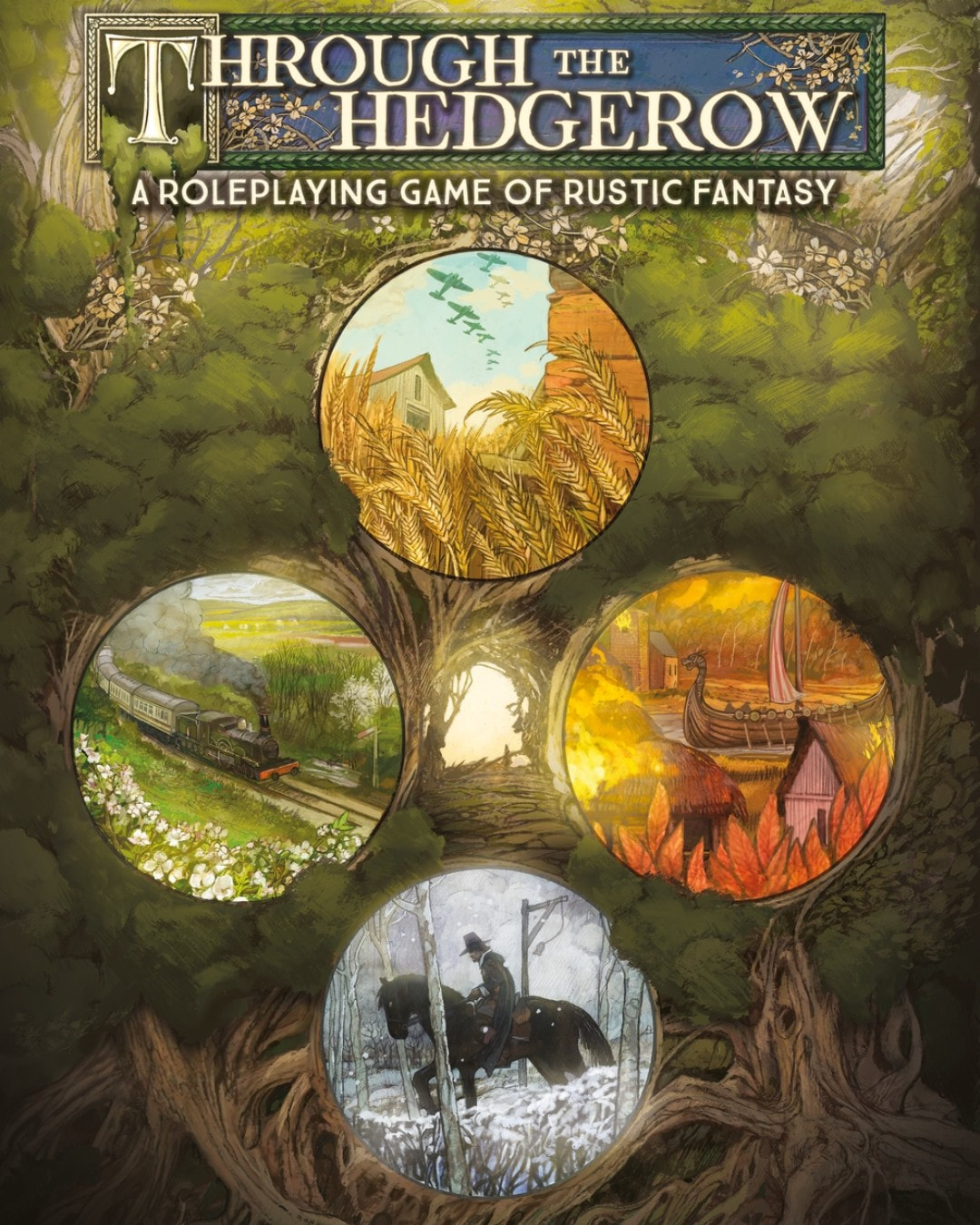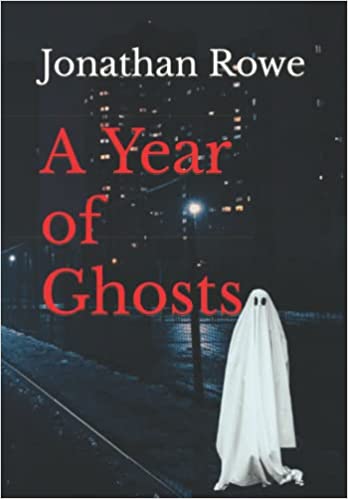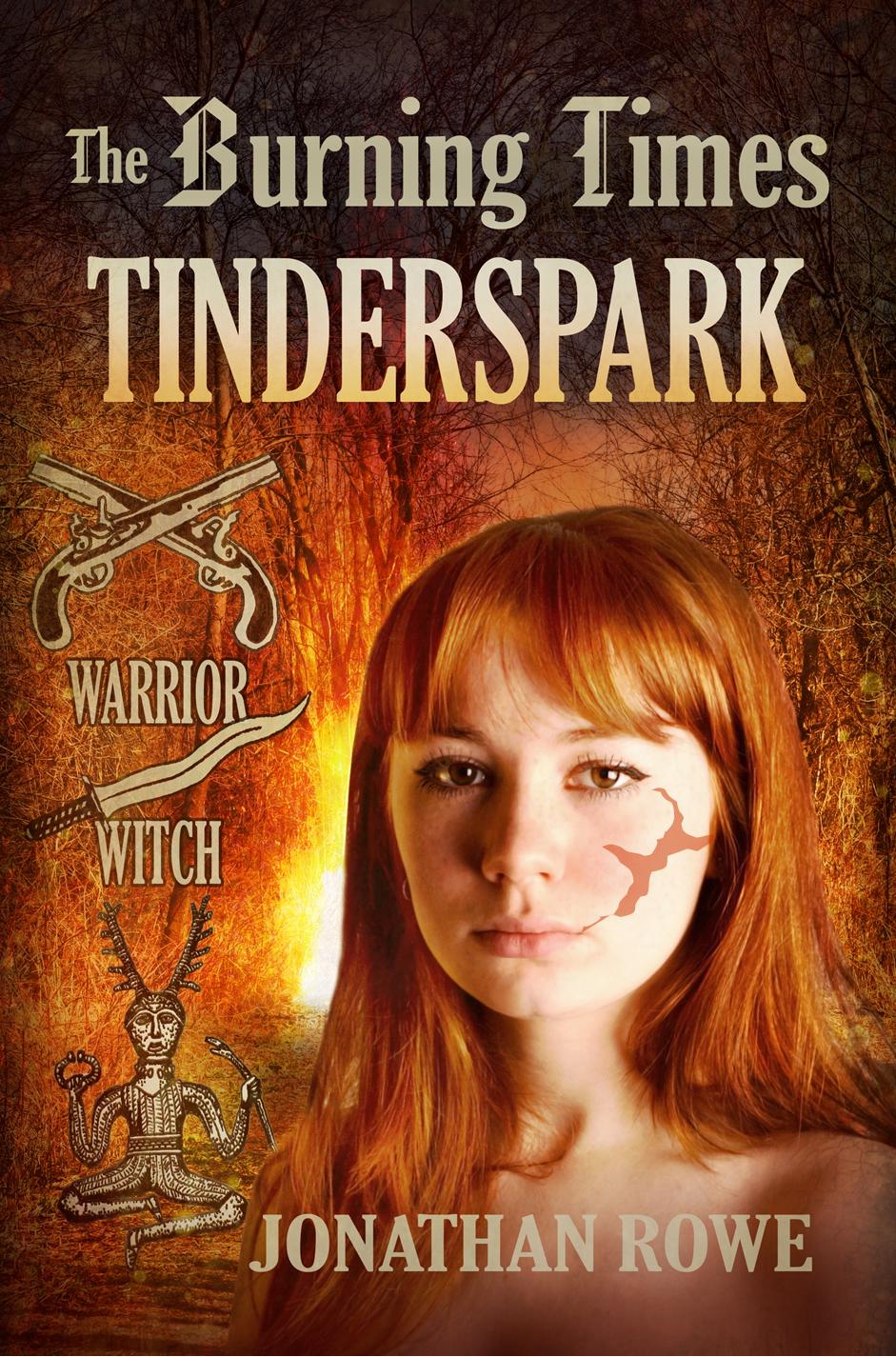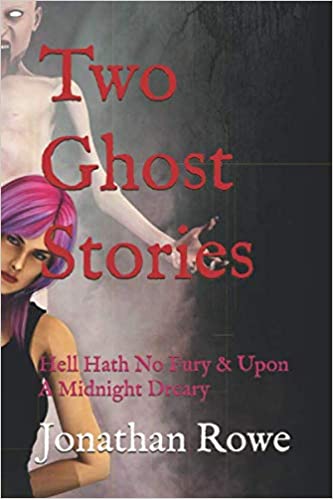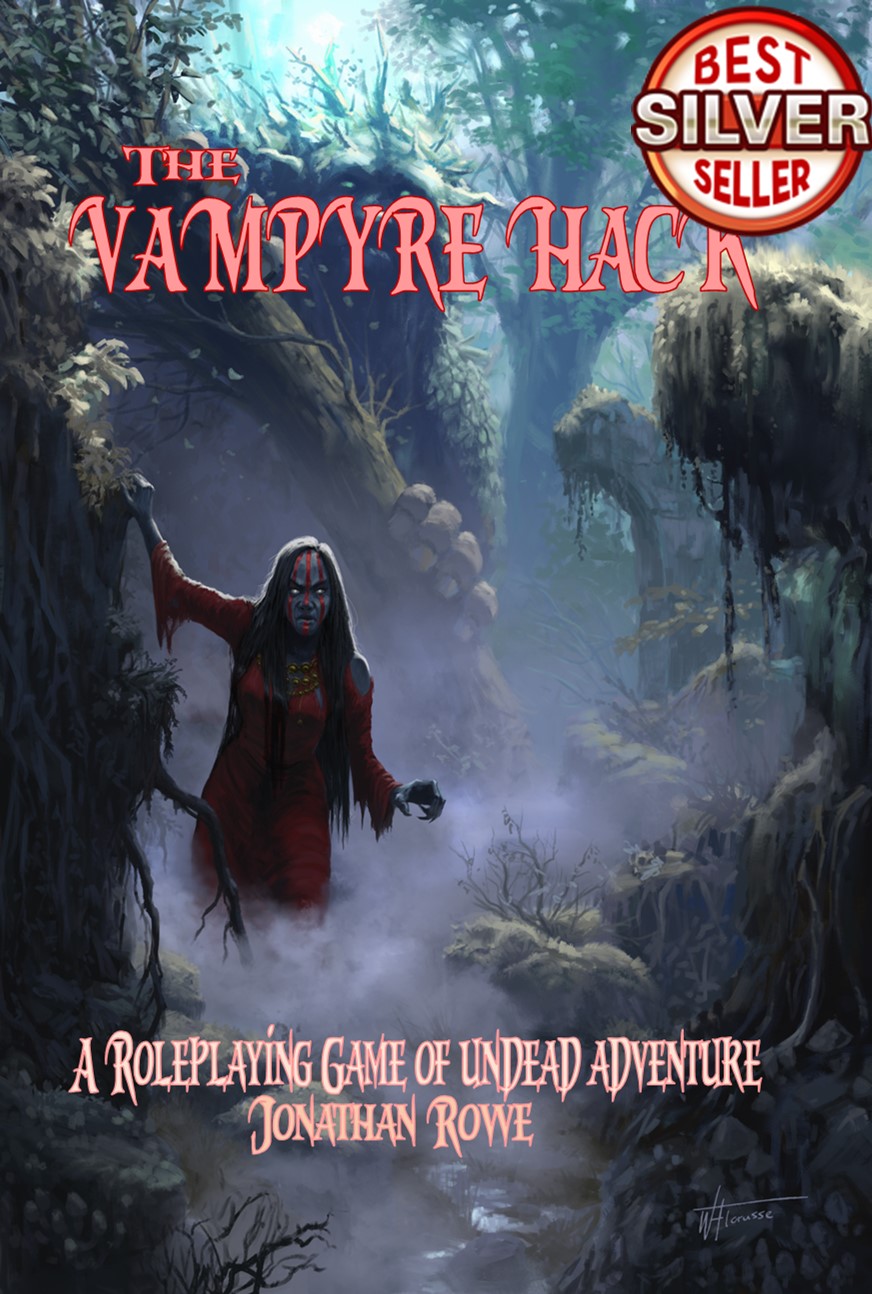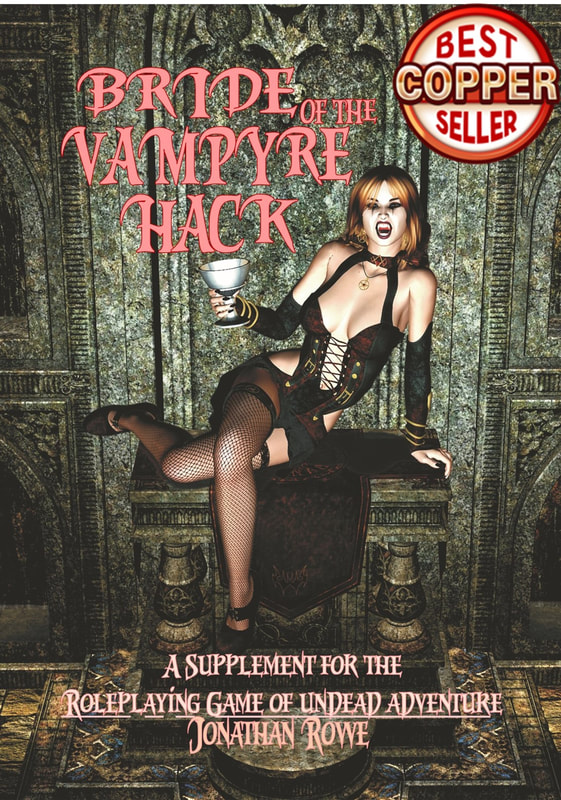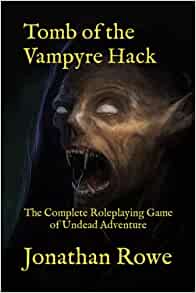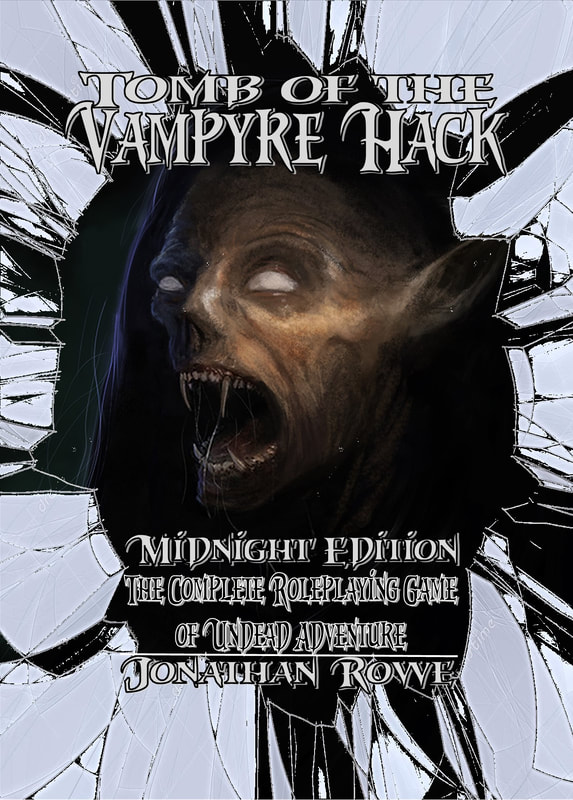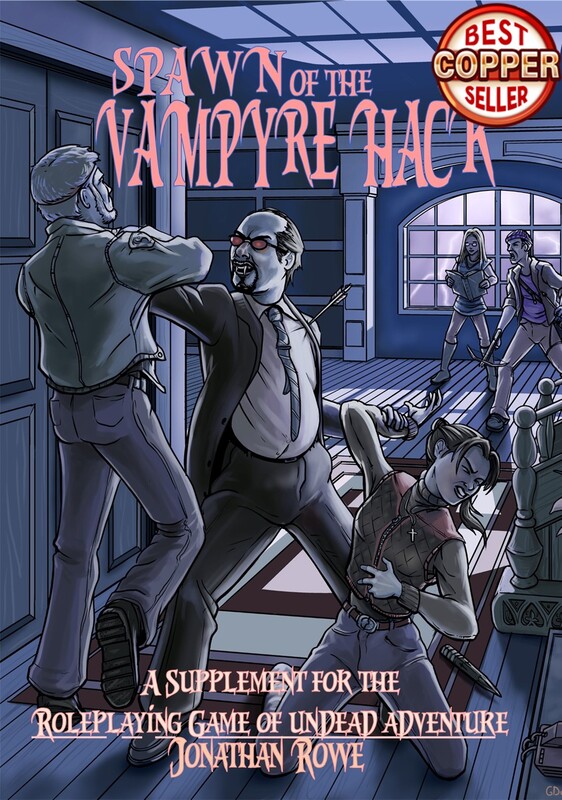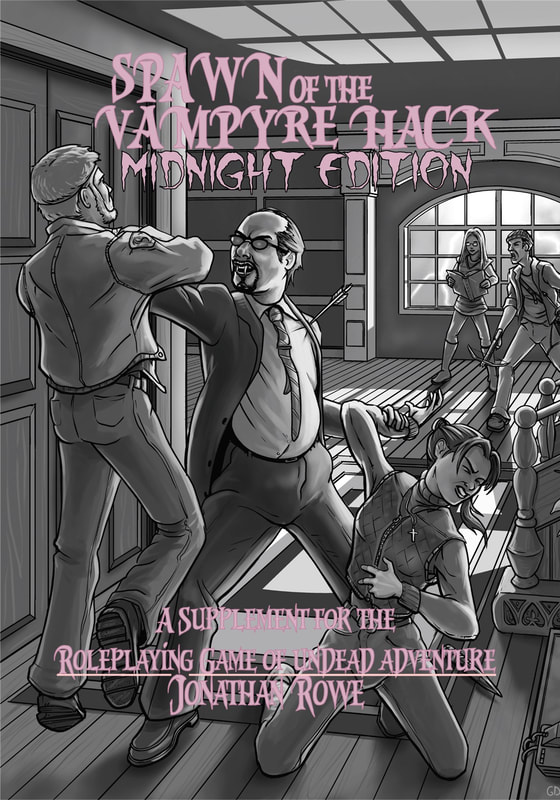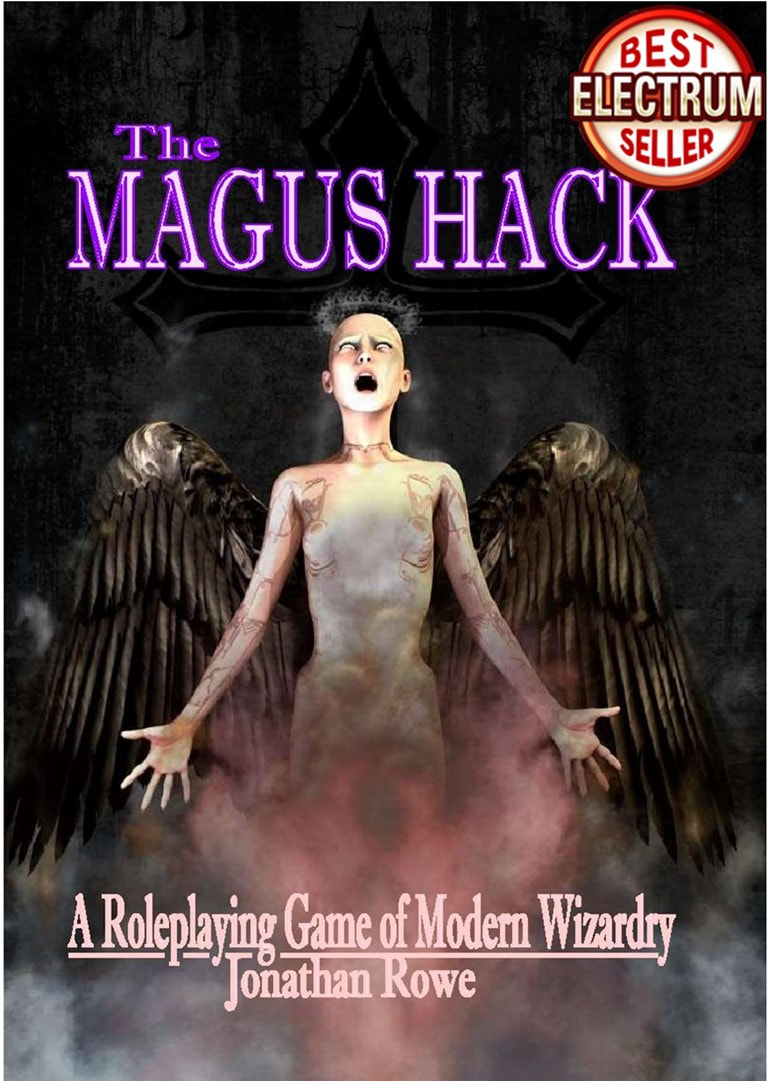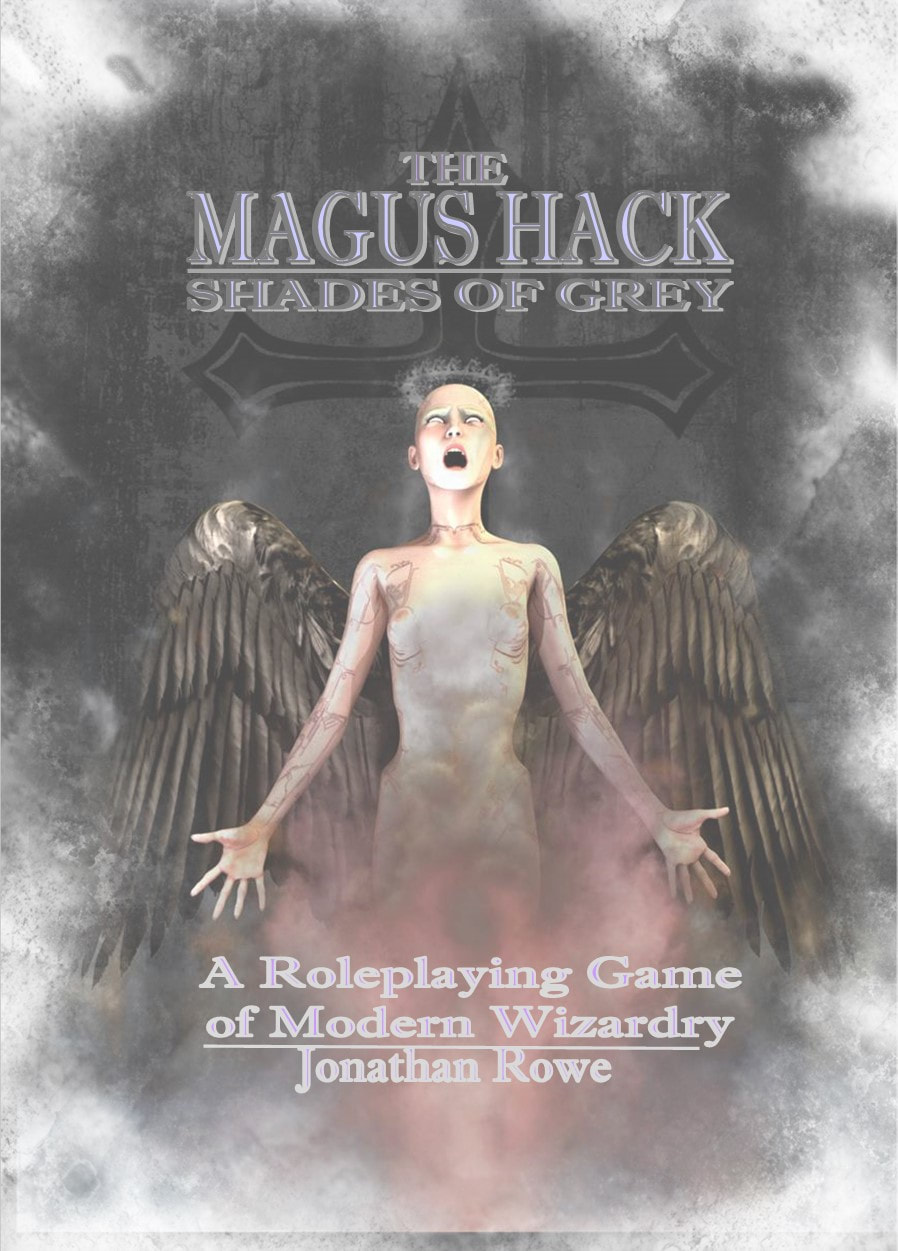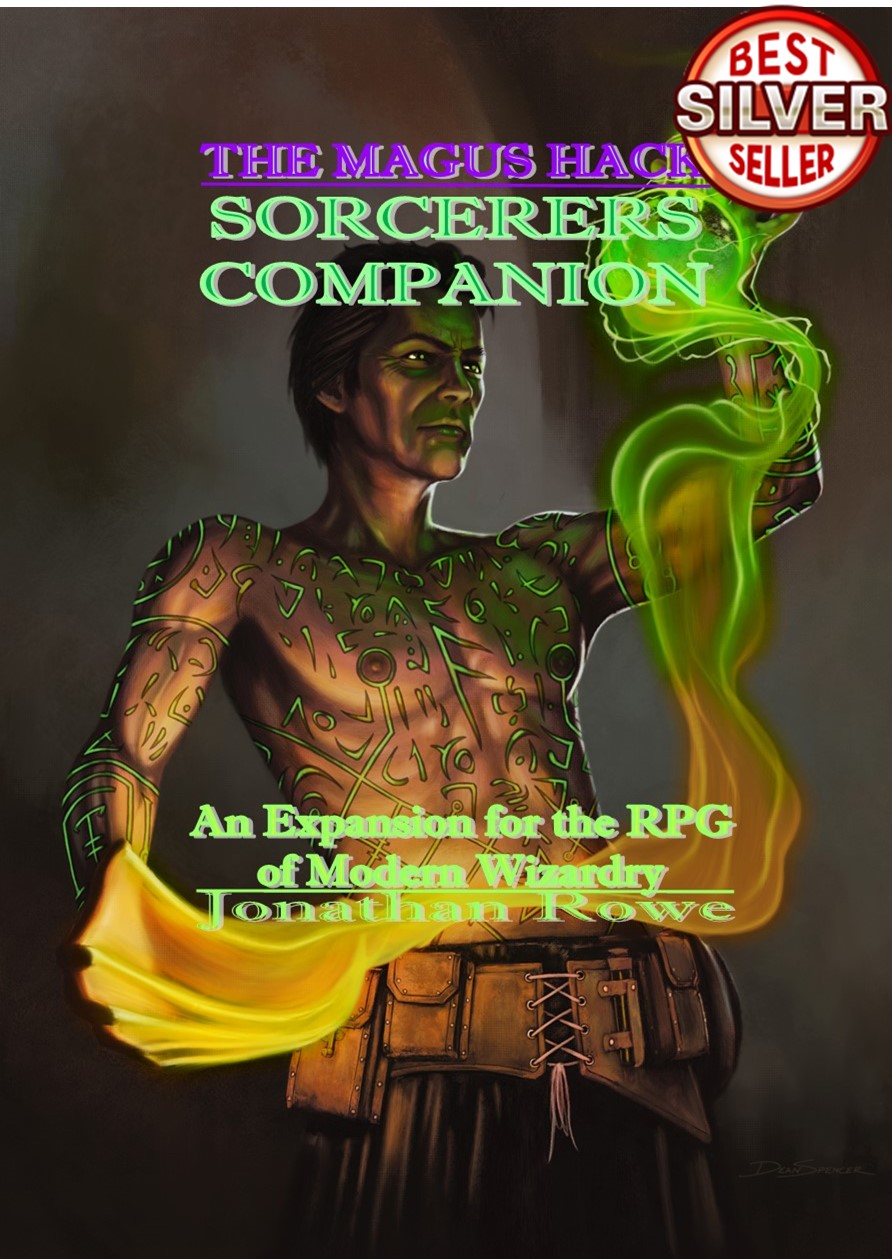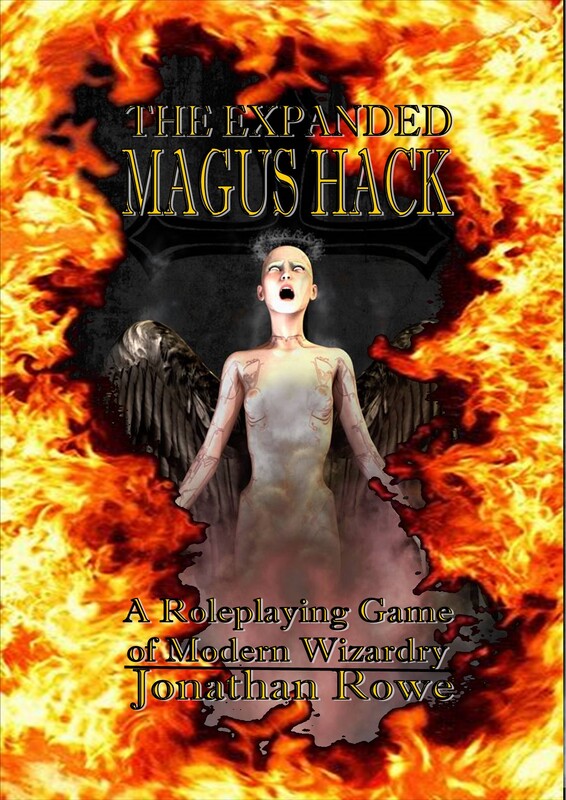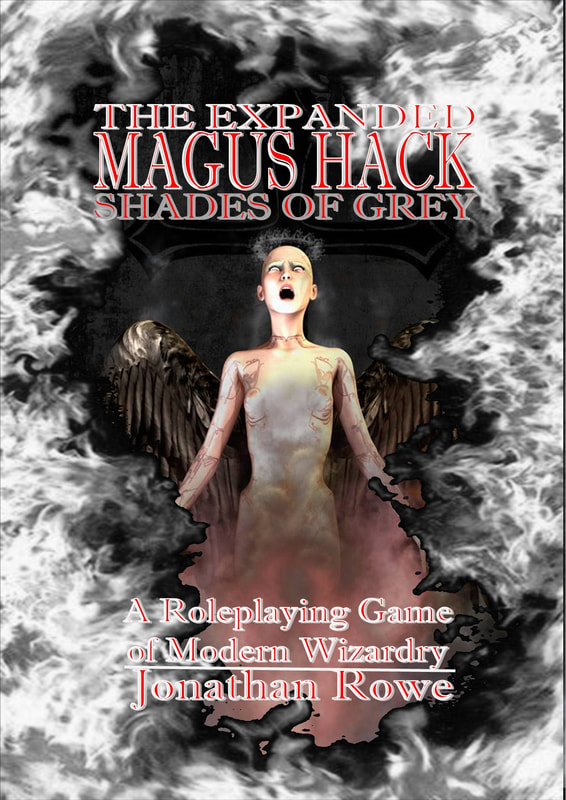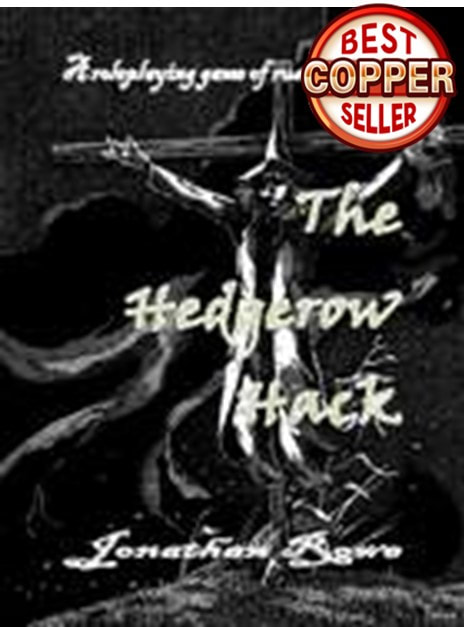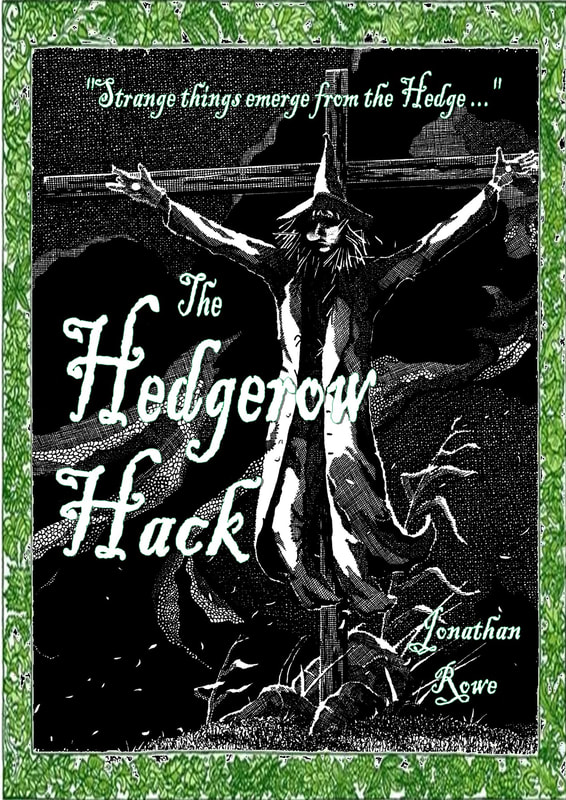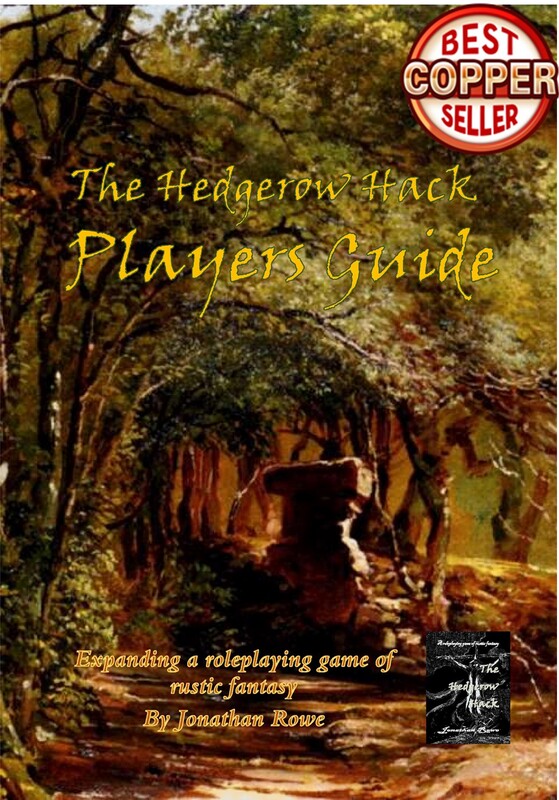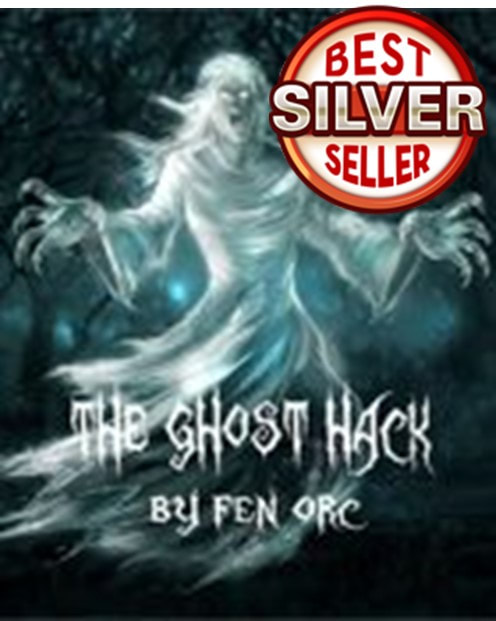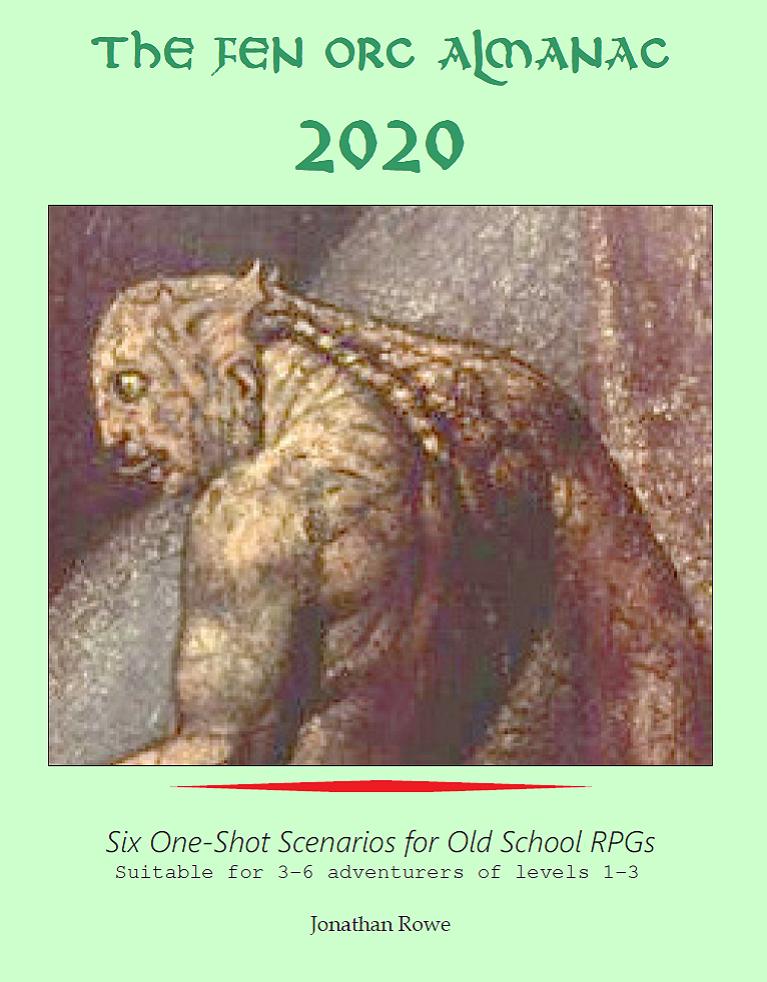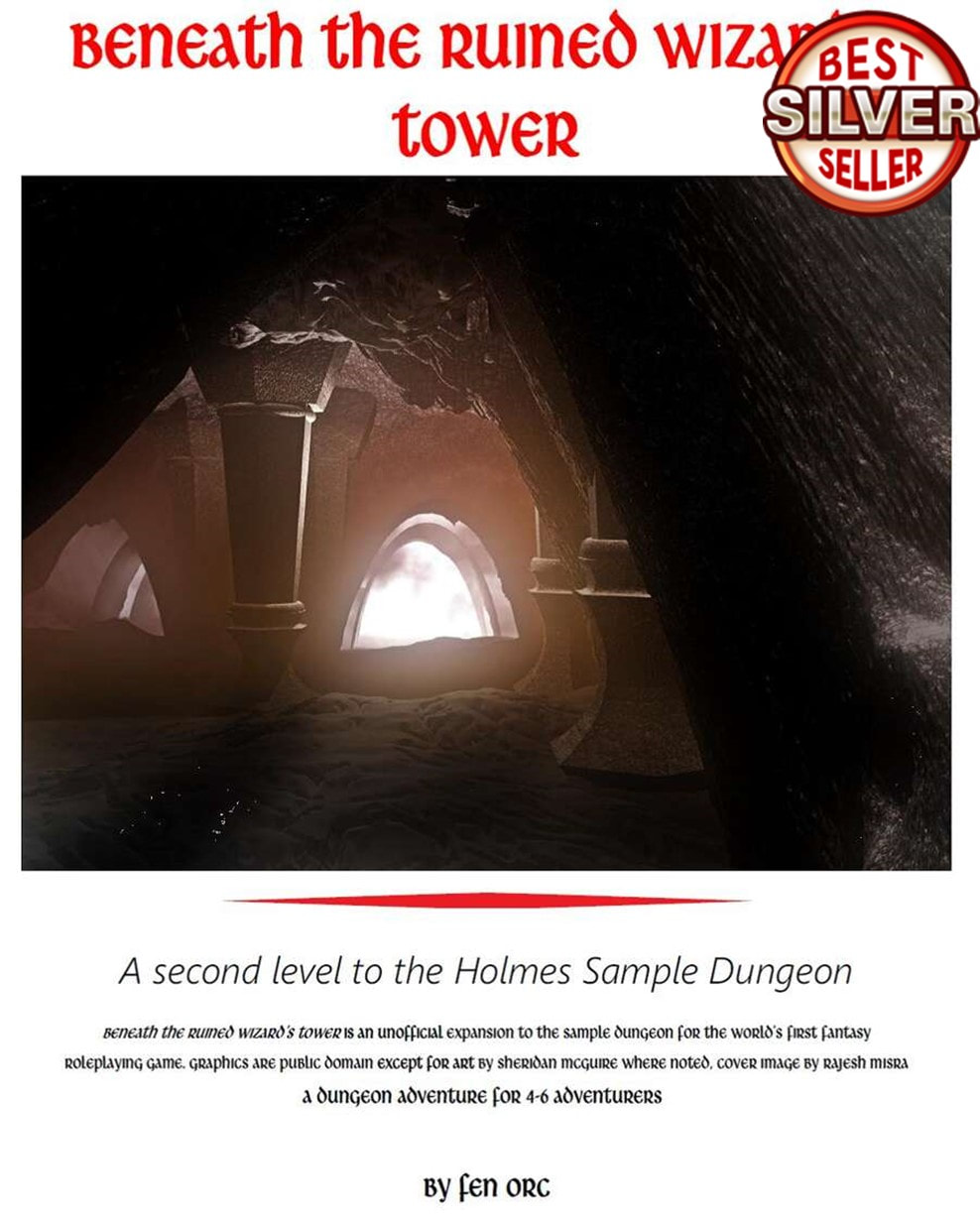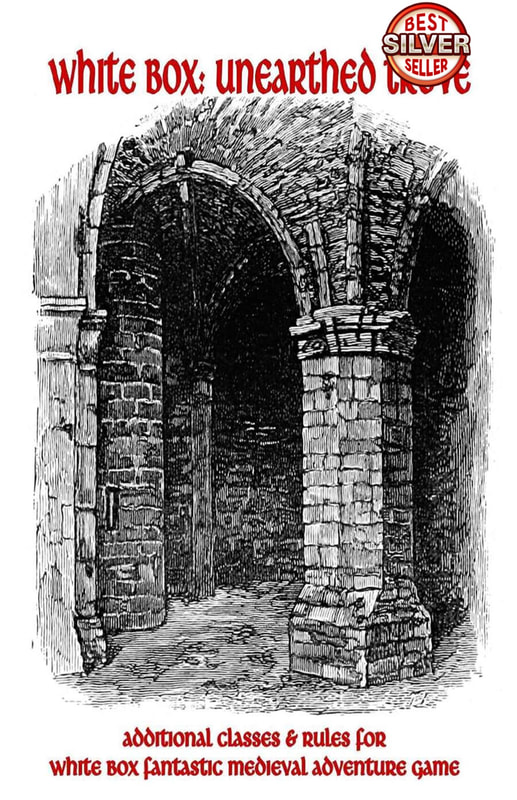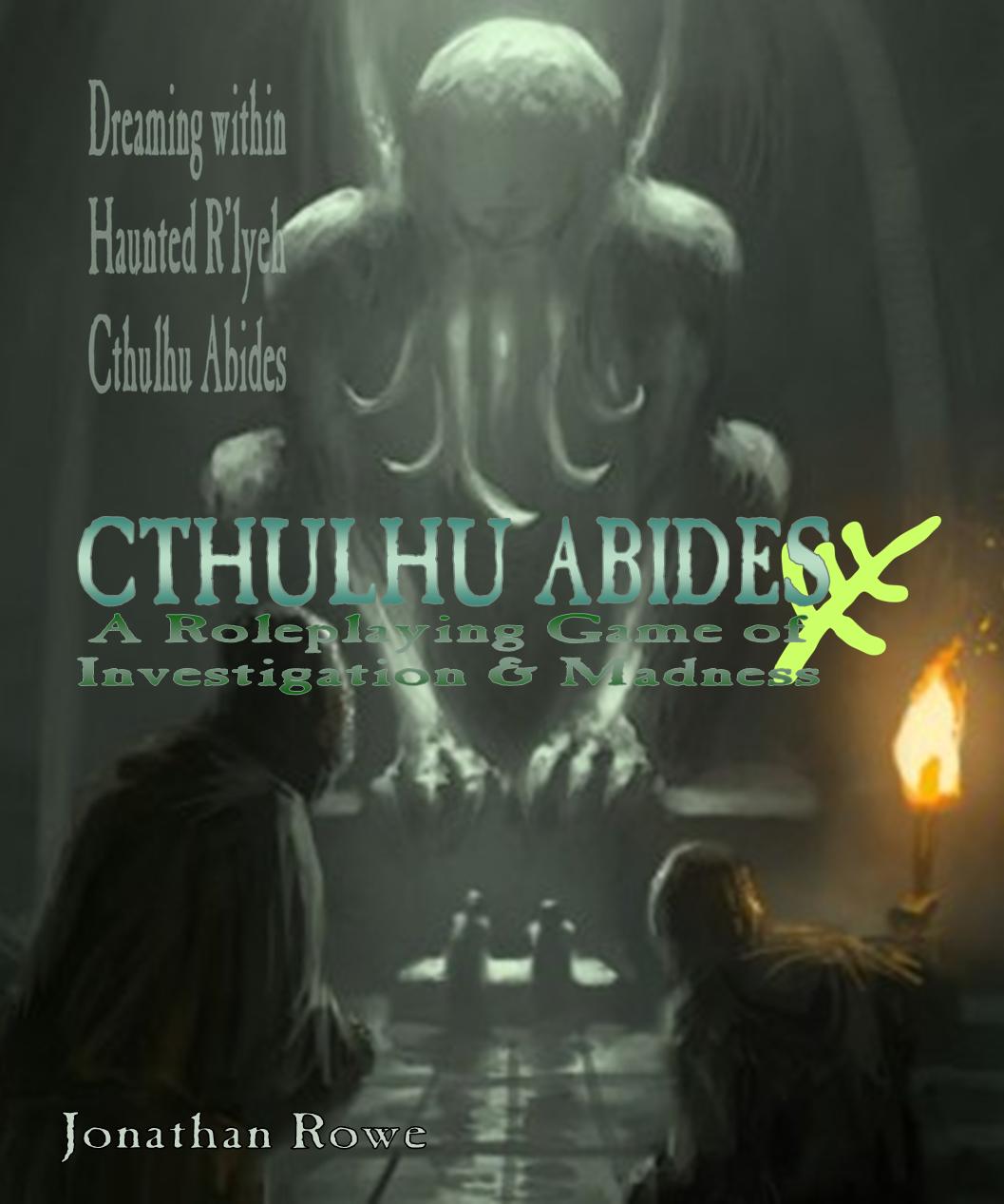Now I know what a ghost is. Unfinished business, that's what Back in the '90s, waiting for the next chapter of White Wolf's World of Darkness game line to see print occupied the space in my life that was later occupied by waiting for Game of Thrones to release a new season. 1991 brought out Vampire: The Masquerade and then Werewolf: The Apocalypse in 1992 and Mage: The Ascension in 1993. By 1994, I was a frothing fan and the arrival of Wraith: The Oblivion was a bombshell, with its fantastic cover of interlinked chains, moody spectral art and surreal, grotesque setting of the rotting Shadowlands and hyper-real Tempest, with slave-harvesting wraiths and Oblivion-worshiping Spectres. Mind. Blown. And yet. And yet. Wraith remains the one World of Darkness game that has never worked for me. I've run long campaigns with the other main games but every attempt to launch Wraith has met with, well, dissatisfaction. The closest I came to making Wraith fly was a campaign set in the 18th century Caribbean. Pirate Wraiths are cool. Part of the problem is Wraith's setting. The other World of Darkness games are set in a bleak dystopian version of our world. Although werewolves and mages can step away into the more fantastical spirit worlds, they are still products of this world and this world is recognisable. Wraith is weird. Where are you? A sort of parallel reality called the Shadowlands that both is and yet is not the same as the world the living inhabit. There's a nightmarish hyperspace called 'the Tempest' that extends beyond the Shadowlands and that's hard to grasp too. The moment you start playing Wraith, you butt up against confusions about what everything looks like. Do buildings in the Shadowlands have doors and windows? Are cars real there too? Can wraiths read newspapers and watch TV - or is the paper rotten and the screen cracked for them? What happens if a human stands in a spot which is a Nihil (a portal to the Tempest)? Wraiths get discorporated by rough contact with 'real' things. This makes crossing a street or moving through a house rather difficult. Wraiths are perpetually being bashed into insubstantiality every time someone opens a door into them, drives through them, kicks a ball at them. So where do Wraiths live? What do they do? Wraiths are supposed to be driven by obsessive Passions and tied to Tethers, which are objects or people that mattered to them. Yet they are also supposed to be servile minions in the Hierarchy, a Kafka-esque slave state of the dead. There doesn't seem to be a way to combine both ideas of what a wraith is. Then there's the Shadow, which is your dark-side given voice, whispering in your mind and offering power in exchange for the gratifixcation of its own Dark Passions. If every Wraith NPC has this sort of Jekyl-and-Hyde persona, the social world of wraiths becomes unimaginably weird. The game recommends players roleplay each other's Shadows, ascting as tempters and tormentors to one another. Great on paper, but I've never been able to get it to work. Some players are too amiable to play the Shadow with gusto; others throw themselves into it with such cackling enthusiasm that it derails the plot. All of these existential conundrums weigh down a game that was already way too fiddly. Wraiths have Passions and Tethers, but also Dark Passions and Shadow Thorns, and Memoriam and Angst, they are loyal to a Faction and a Legion as well as a Guild plus their own mortal attachments, as well as ... look, there's a lot to keep track of, a lot of dice to roll, a lot of points to tot up. TLDR: Wraith's concept is brilliant, the execution gets in the way. Let's Hack Away the Dead Wood I've written about my delight in Matthew Skail's The Blood Hack, which takes David Black's ... Hack skeletal rules set and applies them to vampire, creating a OSR spin on the '90s game. This set me thinking, could the Hack system be the way to turn Wraith into the sort of game I could actually play - that my players could wrap their heads around and I could Referee? And could I write The Ghost Hack myself? So, I did. There's a PDF on drivethrurpg but I can't for the life of me make drivethru's print-on-demand system do what I want so the softback physical copy is available through Amazon. Click the image for Amazon or visit drivethrurpg The Hack system is very streamlined. You have the 'classic six' attributes of STR DEX CON INT WIS CHA and you do everything by rolling equal or under them on a d20. Advanatage lets you roll twice, choosing the best, and Disadvantage forces you to choose the worst. David Black's Usage Die mechanic replaces points: every time you use a dwindling resource you roll its die and on a 1-2 it shrinks a step, with d4 being the lowest step after which the resource is gone. 'Soul' becomes a Usage die that you roll every time you apply your supernatural energy to accomplish something. You replenish your Soul by feeding off your Mortal Coil. This is a group of living people and perhaps objects or places that matters to you and it is represented by another Usage Die. Mortal Coil shrinks when you suck spiritual power out of it, grows when you nurture it. The other Usage Die is the Grave Die, which gets BIGGER when you roll 1-2 and it represents your spiritual Rot: a d6 Grave Die means you're still pretty human, with d8 and d10 losing humanity and d12 becoming monstrous. When the Grave Die is rolled you assume your Charnel Form - your horror movie appearance - and when the Die gets too big you stay stuck like that. Four character classes give PCs their main options: Banshees manipulate and trade in emotions, Nightmanes explore the realms of death, Poltergeists can manipulate objects in the living world and Revenants can take form that the living can see. You choose your Crafts to complement your class abilities and off you go. I sourced some nice pulp-style art Out of respect to ghost-lore (and perhaps TV's Supernatural), these ghosts are harmed by iron and repelled by salt. Rather than get bogged down by a metaphysically-muddled Shadowlands, these ghosts are alongside us in our world but insubstantial to everything except solid iron. There are portals to a ghostly realm of Hades - the underworld - which has Paradises and Infernos run by angels and demons (who probably used to be ghosts themselves) and a mysterious city of Dis run by powerful ghosts. Soulfire lets you recharge your Soul if your Mortal Coil is no more and soul crystals make a ghostly currency. A freezing mist - the Dread - emerges from Hades and forces ghosts to shelter in Fanes, which are places of spiritual strength. Ghosts overcome by the Rot turn into Wights, either temporarily or permanently, and wreck havoc. If you want a Ghost Empire built on enslaving the dead, I cover this as an optional rule. Also optional is allowing other players to roleplay each other's 'Rot' if that's important to you. A nice character sheet Is it any good? Well, you'll have to tell me! Reviews are much appreciated! Contact me for a copy! There comes a point with the Hack games where, if you add on too many fiddly sub-systems, the essential simplicity has been lost. I think the Ghost Hack sails close to that but stays on the simple side: you can tell complex stories with sturdy yet uncomplicated mechanics. I'd like to develop The Ghost Hack a bit further. There's a mini-campaign I want to get onto paper at last - with the PCs haunting a hospital with a strange past under threat from terrorists with a sinister agenda - and my next project (The Fey Hack) will tie in with the Ghost Hack, because ghosts and fey should adventure together. In folklore, they are almost indistinguishable.
0 Comments
Milton's poem describes the poet waking from gloom to throw himself into the busy tumult of life, traveling from the farm, through the beautiful countryside, to the city, and a life given over to pleasure and romance, with poetry being the highest pleasure of all. It doesn't start in the lovely city. The poem begins in a place of nightmare: Hence loathed Melancholy, It's quirky that Milton's description of his nightmares resembles a dungeon adventure, with Cerberus the hell-hound, Stygian caves and Cimmerian deserts. The whole poem (whose title, L'Allegro, means 'The Happy Man') reads like the experience of dungeon adventurers, returning from their harrowing escapade through the peaceful realms, past farms, through woods, at last to a great city, where they will spend their loot and, y'know, level up. Ah. Downtime. Every Referee has his or her own system for it. Go to drivethrurpg and there's an embarrassment of house rules on offer. No one needs to add to this tottering pile. So obviously I'm going to tell you about mine! But I'll make up for it by explaining my thinking as I go and maybe raise a few issues about why we need systems like this in Fantasy RPGs - and why we don't. What's Downtime for? In a nutshell, roleplaying. Look, in some idealised gaming world, there would be no 'downtime': the roleplaying experience would move seamlessly from the quest or dungeon to the home town, to the Green Dragon Inn in Portown, to negotiations with merchants and feudal lords, reunions with family and friends, flirtations with lovers, marriages, funerals, the highs and lows of a life well-lived. Fighting monsters and unearthing treasure would be one of the things fantasy adventurers do - but they would also ask Rosie the barmaid to marry them. And really, which would be the greater achievement? But it's not always so easy. Some Referees are uncomfortable narrating domestic joys and tribulations, some players find it boring; at the end of an adventure many gamers (players and Referees) are tired and want to relax with treasure distribution and XP calculation, not launch into arduous personal roleplaying. The sheer open-endedness of downtime can be daunting: at least with a dungeon the Referee can plan things out in advance. Before Lockdown moved us online and into more conventional dungeon-bashing, I was running a One Ring campaign set in Bree. The characters were humble Hobbits, a Dwarf tinker and a troubled Woodsman and much of the roleplaying revolved around running their businesses, pursuing their love lives and exploring their families and neighbours. In other words, activities that would usually be assigned to Downtime dominated the roleplaying. The players found this refreshing and addictive but, for a Referee, it was fatiguing. Moderating a dungeon-crawl is, by comparison, a relaxing activity. Ignoring Downtime is unsatisfactory too. The PCs end up lacking a context and a world outside of adventuring. They accumulate huge amounts of loot but have little to spend it on. My Downtime system is based on a couple of core concepts:
One last note. I'm using White Box: Fantastic Medieval Adventure Game alongside Simon Piecha's Expanded Lore supplement with his rules for Feats. White Box condenses the whole D&D level system into 10 levels (well... 12 for Magic-Users) and the dice rolls here are based on that rather condensed approach. Staying at the Inn Staying at 'the Inn' between adventures is a sort of default option for players who really don't want to engage with Downtime or who need to save money. Time passes, you heal your Hit Points, it doesn't cost much, then back down the dungeon we go.
Adventurers heal 1 HP for every day of rest; luxury guests can add their Constitution Bonus to this. Merchants at the Inn will buy gems and jewellery but will only offer 50% of its value. No one will buy or sell magic items. Going to the Big City Accommodation in the City charges double the rates of an Inn. During each week in the Big City, players engage in City Activities.A character may undertake 4 activities per week modified by their Charisma (from -3 to +3) but each activity may only be chosen once. These activities usually have a cost based on a d8 die roll and a multiplier. For some activities, the cost is multiplied by the character's current level. Many activities generate Favours or Insights, which are explained later. All die rolls are capped by the player character's level: if you get a result higher than your level, the result is treated as being equivalent to your level. When a character reaches 9th level, builds a stronghold of some sort and attracts followers, they roll 1d12 instead of the d8. I use an Injury system based on goblinpunch's Death & Dismemberment rules and City Activities marked * are too strenuous to be done while recuperating from an Injury. Bawdiness & Harlotry*: Enjoy the pleasures of the flesh. Have a Random Encounter (roll at +1 or +2 for expensive bawdiness). Cost: 1d8 x 50gp or x 100gp for the expensive sort. Black Market*: Buy illegal goods/hirelings or standard goods/hirelings at 75% cost (contraband, slaves). Carouse*: Drink, eat, dance then do it all over again. Have Random Encounters (one for ordinary carousing, two for the expensive sort). Cost: 1d8 x 10gp or x 100gp for expensive carousing. Craft*: Manufacture potions, scrolls and other magic items at higher levels. War Smiths create arms and armour with this activity (which represents spending up to 5 Craft points). Debt Management: If you overspend, this MUST be your next City Activity. Visit your debtors. Spend a Favour. Add 50% to your debt. You can do this once, plus one extra time for each bonus point of Charisma. Debtors will send collectors (i.e. assassins) after a month. If you leave the city without meeting your debtors this way, the debts are doubled and the collectors/assassins are dispatched after a week. Devotion*: Carry out the rites, sacrifices and services of your religion. Gain 1d6 Insight. Optional: roll a Random Encounter. Cost: 1d8 x 100gp per level. Fence*: Sell stolen gems/jewellery or illegal valuables to criminal deals. You will get 50% of the value. Gambling*: Dice, cards, pit fights and races. Spend the cost then pass a Saving Throw to recover it and another Saving Throw to double it. Thieves and Street Mages add +2. Have a Random Encounter at -1. Cost: 1d8 x 10gp or x 100gp. Good Works: Devote yourself to a project you believe in. Gain 1d8-1 Favour and 1d8-1 Insight (0 means nothing is gained). Cost: 1d8 x 100gp per level. Lotus Eating*: Take mind-bending drugs and lie in a stupor.Gain 1d8-1 Insight (0 means nothing is gained) or 1d8 Insight for Luxury Lotus. Gain 1 Trauma. Have a Random Encounter at -2 or a normal Random Encounter for luxury Lotus). No further activities this week. Cost: 1d8 x 25gp or x 150gp for luxury Lotus. Magickal Market*: Spend a Favour to inquire to buy a magic item or sell one. If buying, roll a magic item randomly (White Box p117) to see what is for sale. The cost is in Favour/Insight. Potions and Protection Scrolls cost 10 Favour/Insight, 25 for Lesser Items/Lesser Rings and 50 for Medium Items, Lesser Wands/Staves and non-unusual Arms/Armour. More powerful treasures are not for sale: if you roll these, treat "nothing for sale this week." If selling, the PC earns half the sale amount (5, 12 or 25) but can choose whether to be paid in Favour, Insight or a combination. Optional: roll a Random Encounter. Market: Buy standard equipment and recruit Hirelings at normal prices. Optional: roll a Random Encounter. Physicks and Leeches: Hire a skilled doctor to treat you. Add +1 to the number of HP you heal each day and heal 1 Injury (in addition to any normal healing). Cost: 1d8 x 100 gp Politicking*: Meet with the movers and shakers and influence their plans. Gain 1d8 Favour. Optional: roll a Random Encounter. Cost: 1d8 x 100gp per level. Quest*: There are downtime quests, like following a treasure map. Cost: 1d8 x 10gp for supplies, porters, horses. Spiritual Comfort: Hire a cleric or mystic to help you pray or meditate on your problems. This counts as Spiritual Comfort, removing 1 Trauma for a week of rest (no * activities) and removing 1 point of Derangement after 4 weeks of rest. Cost: 1d8 x 25gp (or 1d6 x 100gp for a month). Study*: Visit a library, laboratory or Sage to find answers to questions. Cost: 1d8 x 100gp. Trade: Sell your gems and jewellery to respectable dealers. You will get 75% of the value or 100% if you spend 1 Favour. Training*: One week of training per level you currently possess is required before you can advance a level in your class. You must spend 1 Insight or Favour to use this activity. Spending extra Insight or Favour halves the cost (multiple Insight/Favour may be spent in this way). Cost: 1d8 x 100gp per level Work*: Spend a week earning money from your profession. Thieves may roll twice and choose the higher amount. Assassins roll Assassinate ability and claim fee if successful. Gain XP equal to 50% of your earnings. Optional: roll a Random Encounter. Gain: 1d8 x 10gp per level Horatio is a 3rd level Magic-User with a +1 Charisma Bonus so he gets 5 City Activities a week. He spends his 10gp accommodation undertakes these activities:
At the end of a week, Horatio has completed a third of his training, gained a Trauma and spent 1,135gp. He also earned 90gp and realised 1,000gp cash from some dungeon loot. He has to roll on the Encounter Table from his lotus binge. Random Encounters must occur while Carousing, Gambling, Lotus-Eating or carrying on with Bawdiness & Harlotry and are optional with several other activities. They are rolled on 2d6. Charisma Bonuses apply, but there is a penalty of -1 if you have debts and -1 per Favour you owe to NPCs. Favour can be lost and turn into negative favour (Favours you owe rather than favours owed to you) but you cannot reduce Insight below 0. Horatio has a +1 Charisma Bonus and rolls 7, minus 2 (for cheap lotus) and plus 1 (Charisma), resulting in 6: someone robbed him while he was at that drug den. He rolls a d8 and the result of 8 is reduced to 3 (because he's third level) so Horatio has lost 90gp. That was his weekly earnings! Horatio begins a roleplayed encounter as he blearily pursues the thief through the night time streets. Favours & Insights Favours/Insights are a sort of currency for Downtime, representing leverage with NPCs or institutions or else your own growing understanding of plots, factions and power in your community. Ideally, I like to turn each favour or insight into a roleplayed moment: an incident, a new NPC, a flashback or cut-scene. Insight can be traded for a (true, relevant) rumour about a dungeon. Insights can be spent to engage in Training or halve its cost.
Favour can be used to get the full gold value of a Trade or 75% for a Fence/sale of a magical treasure. A Favour enables you to manage your Debts or engage in Training. A Favour can also be spent to halve the cost of a week’s training.
Horatio has 3 Insight and 2 Favours. As a third level Magic-User, his To Hit Bonus is +0 so a temporary Feat costs him a basic 1 Insight. He purchases Iron Will for +2 to all his saving throws during the next adventure. He wants someone to cast continual light on his dagger so he doesn't have to worry about his torch going out. This is a 2nd level spell so spending 2 Favours will turn up a friendly mage willing to cast the spell. Horatio trades his other Insight in for rumours about the dungeon. Reflections Homebrew rules are funny. You create them to be as simple and unfussy as possible, but anyone else looking at them sees only a dog's breakfast of otiose tables, dice-rolls and redundancy. Then they offer their suggestions which strike you as insanely baroque and over-complicated. Ah well... I wanted this system to be ABSTRACT. I didn't want it to dictate to me that Dian the Cleric has been mugged in an alleyway by 3 fifth level Thieves or that Konall the War Smith has offended the Dowager Princess' favourite eunuch. Those are campaign specifics that I can come up with myself once I know that someone has lost money or made an enemy. I get that some people want a system to tell them much more detailed events but that's just not a requirement for me. I also wanted the system to be EXPENSIVE and it's been through several drafts to get the economics right. Players emerge from dungeons with huge amounts of loot. I want to take it off them, partly so that they value finding the next haul and partly to provide an economic incentive for adventuring. Arranging the money and the Favour/Insight to go up levels is becoming an abiding concern for players and I think that's as it should be. My early drafts were too punitive, though - I think this one is about right. I want the system to LEVEL UP because D&D is all about levels. First level characters potter about, gambling with small stakes, making modest donations, politicking with low-tier bureacrats, carousing in inexpensive taverns. Higher level characters incur much bigger costs for greater benefits. A first level character might spend 100gp at the temple and earn a single Insight but a fifth level character could part with 2,500gp for 5 Insight. That's why fifth level characters are down on the lower dungeon levels, doing dangerous stuff for big rewards. Favour and Insight quantify the ebb and flow of a character's influence and awareness about what's happening in their world. Using them as the currency for magic items and spells spares me quantifying the cash value of a +1 sword or getting remove curse cast to remove that lycanthropy. The option to buy 'temporary Feats' lets PCs power-up ahead of important or dangerous missions. They also generate roleplayed encounters, in-character flashbacks and NPC allies, patrons and contacts.
Remember Vampire: the Masquerade? Mark Rein-Hagen's broody vamp RPG crashed into the hobby in 1991 and changed everything. It established White Wolf as a major gaming industry name and their Storyteller System as an influential rules set. It opened the World of Darkness as a compelling modern day setting, with contemporary heroes exploring a 'Gothic Punk' version of the world we know, one where supernatural evils manipulate humanity from the shadows. Perhaps most importantly, it offered a radical approach to roleplaying, with anguished characters possessing vivid inner lives, a focus on themes over action and a sort of bruised romanticism that hooked players at once. In Vampire, you play the monster, but you are horrified by what you have become and what you might turn into. I was drawn in by V:tM's coffee-table chic. So minimalist. So teasing. The 1st edition cover gave nothing away beyond "A Storytelling Game of Personal Horror" Vampire presented us a world familiar from much-loved '80s media - the American heartlands of Indiana, Illinois, Wisconsin, the world of Ferris Bueller, The Breakfast Club, the music of John Cougar Mellancamp and Bob Seger, the Blues Brothers, Halloween. Then it flipped it, focusing on the decaying industrial 'Rust Belt' and the hollowed-out cities. The mythology of feuding clans and warring sects, the historical revisionism that placed undead puppet-masters behind civilisation's great events, the concept of a 'Masquerade' that exposed the wholesome suburbia of a John Hughes movie to be a cynical lie... That's a heady cocktail. Vampire and its successor-games (werewolves, mages, wraiths and changelings) pretty much defined '90s roleplaying. Gone were the gritty, matrix-dominated high fantasy worlds of the '80s - take that, Rolemaster! - and in came improvisation, drama, roll-the-dice-then-make-something-up. Light candles! Play a Dead Can Dance CD! Wear a funny hat! Vampire didn't birth LARPing but it gave it focus and White Wolf threw itself behind the LARP trend with its 'Minds Eye Theater' line. LARPers. Crikey! I loved Vampire as much as anyone. It probably sustained my post-university interest in roleplaying which would have faded away otherwise, under the squeeze from career and family and ennui with dungeons and, I suppose, dragons. The great thing about Vampire was that the scenarios wrote themselves. Session One, you awaken as a vampire and you have to go and find food. From this premise, everything else flows and the tragedies, misadventures and dilemmas of that first night on the prowl set everything else in motion. You have to hide a body. You've offended another vampire. You've been discovered by your boyfriend. You've been introduced to the vampiric Prince and he wants you to do a little job for him. It wasn't perfect though. The Great Handfuls Of Dice (GHOD) offered a cluttered and blunt mechanic that didn't allow meaningful assessment of risk. No matter how many editions the game went through, they couldn't fix overpowered Celerity or underpowered guns. Roll all these and tell me if you hit... New Clans and Bloodlines were twinky and power-creeping and, from a 21st century perspective, insensitive in the representation of race and culture (so... Gypsies vampires are all thieves and the only two black factions are devoted to murder and demonism?). The representation of Middle Eastern vampires as a clan of fanatical assassins... problematic! And of course, that intoxicating lore which was such a springboard for the imagination back in '91 got codified, nailed down, explicated and quantified. It became a straightjacket, with its canonical timelines and dominating conflicts. Although a supplement exploring the anti-human Sabbat sect was extremely imaginative, it took the Jungian 'Shadow' of Vampire and gave it a face and the night lost its mystery as a result. There's a new version of Vampire: the Masquerade out - 2018's 'fifth edition' - and it's supposed to be very good. It takes a root-and-branch approach, restructuring the (terrible) dice system and Year Zero-ing the convoluted mythology. It can't overcome the game's '90s legacy, it seems, and has encoded characters with neo-Nazi iconography. Edge-lordery or Ass-holery? I can't comment. I've not read it. The reason I'm not wading back into Vampire: the Masquerade is that I've discovered The Blood Hack. I can buy the new 5th edition for £18 as a PDF - which is good value for a slick product - or The Blood Hack for £3 from drivethrurpg Author Matthew Skail describes The Blood Hack as "a love letter to dark games of the 90's that allow you to play the monster!" So we know what he's talking about, right? A bit of context. There are a lot of ...Hack RPGs out there, but the progenitor is David Black's The Black Hack (2013). The Black Hack is a super-streamlined retroclone of original D&D that takes a lot of liberties in order to capture the essence of Old School dungeon-bashing. It replaces all the tables and matrices with a simple mechanic: roll a d20 and get equal to or less than your relevant attribute (STR, DEX, etc). Players do all the rolling so you test STR to attack a monster and STR again to avoid being damaged by its attack. Saving throws are tests of CON or DEX or whatever. You might have penalties (actually, plusses, since you're trying to roll low) but the usual mechanic is to roll with either Advantage (roll twice, keep the lowest) or Disadvantage (roll twice, keep the highest). Black's innovation is the Usage Die. If your character has a crossbow it might have a d6 Usage Die. Every time you fire it you roll your d6 and if you roll 1-2 your Usage Die shrinks down to a d4. If you roll 1-2 again, your Usage Die is gone. You're out of ammo. Black applies the Usage Die concept to things like ammo, supplies, rations and torches, to avoid the fiddliness of keeping track of individual arrows or oil flasks. However, imitators have gone much further with this design. A Black Hack character, with Usage Dice Because Black is writing under the Open Gaming Licence, he offers up his game as a 'Hack' and a living document, inviting corrections and additions. Before long, there is a Space Hack, a Zombie Hack and a Cthulhu Hack and many other adaptations of popular RPG properties into this streamlined OSR rules set. Enter Matthew Skail, who takes up Black's distinctive approach and creates a sort of OSR Vampire game: Vampire but with levels and Hit Dice and the familiar six attributes of D&D, with the vampiric bloodlines as character classes. Obviously, intellectual property means that Skail cannot poach the Tremere and Gangrel, but his Anunnaki are sorcerers and Enkidu are shapeshifters, the Dracul are lordly warriors and the Lillim seductive manipulators: if you know V:tM, you can join the dots. Usage Dice do a lot more work in Skail's game. You have a Blood Usage Die and whenever you use it (to power abilities or go without feeding) you roll it and on a 1-2 it shrinks. Characters start off with a d4 Blood Usage Die, so there's a 50% chance any vampy exertion will leave you bloodless and hungry. Top vampires have a d10 Blood Die and you can do a lot with that: it will shrink to a d8 then a d6 then a d4 before you end up bloodless. Have fun! Feeding on a victim lets you take a step of their Blood Die (reducing a human from d4 to nothing) and add it to yours (boosting you from nothing to a d4). You can gorge yourself, taking your Blood Die to a step higher than your level-limit (ie. a d6 for first level characters). Feed on someone without a Blood Die and they die. Morality is also a Usage Die, but this is a die that gets bigger when it rolls 1-2. You start of with a d6 Morality (basic human, nothing special) and when you drain someone dry you roll it and on a 1-2 it increases to a d8. Now you're coldly inhuman in many ways; you're tougher in combat but you need to feed every night and sunlight deals Killing Damage. Vampires with a d10 Morality are nasty, d12 are monsters and d20 are doomed to become NPC horrors. With each step up, you get more vicious in combat but more vulnerable to sunlight, silver and holiness. Skail's vampires don't have reflections (I remember the brilliant 1998 TV series Ultraviolet and perhaps Skail does too because he's alert to the implication that vampires do not show up on film and their voices don't carry over telephones or the Internet). This show rocked and, yes, that's Idris Elba Skail also reinstates silver as a source of Killing Damage for vampires and downplays the idea that they're controlling the world: he presents his clans as engaged in little turf wars rather than directing massive corporations, but of course you can take the game in any direction you like.
There's a comprehensive set of Blood Gifts and you get more by going up levels. Some of these Gifts are permanent powers (you can climb walls!), some require victims to have no more Hit Dice than you (the commanding Voice) and others require a stat test and a Blood Usage die roll. Super-strength 'Might' is another Usage Die that exhausts as you use it and refreshes the next evening. There are Blood Rituals you can use as an Anunnaki or buy into through the Mysticism Blood Gift and these let you create Renfield-esque Thralls, protect your Lair, recreate your reflection and other cools tricks. All of this is packed in to 54 pages with big typeface, lots of white space and some B&W art that's amateur but effective. It's not a perfect document. If you hate typos, then sedate yourself, because Matthew Skail has autocorrect turned 'off'. The ordering of material is haphazard and would be baffling in a larger or more complex rules set. Some material has been ported in from other hacks in a rather undigested way: we get lists of firearms and vehicles and their stats and prices as if this was a set of skirmish rules. but only perfunctory rules on humans, Thralls and vampire politics. The assumption is that you're fighting other supernatural mooks in the night. But of course, you can make use of the game in any way you like. I've found The Blood Hack to be a fantastic gateway back into vampire-themed roleplaying with a OSR aesthetic. It lets me ditch the baggage of the World of Darkness and construct my own setting with vamps who are rather more mystical and varied than the White Wolf varieties. I've started a campaign - Nights of Fire, set in London in 1940 on the eve of the Blitz - and of course that's going to end up hacking the Hack, with my own rules and variants, new clans, new powers, all of that stuff. The Blood Hack doesn't have Malkavians! That so needs to be fixed... We're playing a campaign using White Box: Fantastic Medieval Adventure Game, which makes a virtue out of simplicity. We like to impose a critical hit (maximum damage!) on a 20, so there needs to be a critical failure on a 1. Currently we go with the old drop-your-weapon standby. There's nothing wrong with drop-your-weapon (DYW). It's simple. You can spend a round picking it up again (foregoing your attack) or someone else can pick it up for you (foregoing their action) or you can just draw another weapon and bash on with that. I note with a sinking heart that White Box uses the ghastly one minute melee round (p31) that Gary Gygax introduced for AD&D. Why?!?!? I wrote about this back when I was reviewing Forge: Out of Chaos. In a one minute melee round you have plenty of opportunity to pick up a dropped weapon yourself. Needless to say, my White Box melee rounds are a brisk 10 seconds. The problem with DYW is that it gets a bit boring. Players never get tired of dealing maximum damage but they do get fed up of dropping their weapons, especially the Dark Elf War Smith whose warhammer seems to be made out of banana skins. DYW also gets comedic, which is fine on some occasions but not the vibe you want in more dramatic showdowns. I need to resist the urge to create a complicated Critical Fail table, partly because this is White Box here and partly because whatever I create for PC fumbles will have to apply to monsters too and, as a Referee, I don't want extra book-keeping. Option 1: Fumbles Are Stressful I already use the Trauma & Insanity system, adapted from Goblinpunch. I find it pretty easy to track and it doesn't alter the structure of the game too much, but it helps spotlight scary moments and indicates to players when danger is looming. So far only two characters (both belonging to the same player!) have contracted any permanent derangements, but a few people have had awkward breakdowns. A simple mechanic is: if you roll a natural 1 in combat, gain a Trauma point. Of course, you then have to make a Breakdown Test by rolling over your current Trauma on a d20 (Wisdom modifiers apply) and if you fail that you freak out in the manner of your choosing for 1d6 rounds or else 'suck it up' and waive the penalty at the cost of taking on a derangement. This means combat fumbles don't always produce a bad side-effect, but they contribute to your overall stress and, when they do explode in your face, you could be quite severely discomfitted. The beauty of this is elegance: it relates to a mechanic I already use and my players understand and it's a mechanic which periodically causes PCs to freeze or flee or freak out. Of course, it doesn't apply to monsters - instead, a Natural-1 could cause them to make a Morale Check. There are some monsters (Berserkers, Undead) who simply don't fail Morale Checks, so a Natural-1 is just an ordinary fail for them. Is that a problem? Option 2: Fumbles Are Feints Another view is that a fumble in combat represents, not your clumsiness, but your opponent's craftiness. They feinted or somehow drew you into a reckless attack that exposed yourself. A simple mechanic is: the enemy you are attacking gets a free attack. In other versions of D&D, this could be quite punishing, but remember two things:
The beauty of this is that it speeds fights up by adding in extra attacks now and again. Given the damage output that PCs have, it probably plays in favour of PCs. It rewards high-HP, high-AC characters who can endure multiple attacks. Most importantly, it's REALLY SIMPLE. You roll a 1 and your opponent hits you: simples. Option 3: A Critical Miss Table It's a classic solution:
This was my first solution, but on reflection it's the least attractive. It's another damn table to roll on. The results won't always make sense in the narrative. It can be unintentionally comedic at the wrong times. But it does introduce uncertainty and drama to combat. One option is to decide which to use on a case-by-case basis, announcing it at the start of any given fight. Being swarmed by Giant Rats or an army of rotting Skeletons is stressful, so Option 1 fits best: your fumbles means the rats are in your hair, the skeletons' bony fingers are at your throat. A duel or matched melee against humanoid opponents fits Option 2 better: you are both trying to break through each other's guard. A party attack on a big enemy fits Option 3 better: if you are all fighting a Dragon or a Giant, it keeps swatting you away and deafening you with its roars.
It's time to go way back. I'm talking White Dwarf 4 (1977/8) and Brian Asbury's Barbarian character class. This is the Barbarian from the twilit time before the Players Handbook (1978) introduced AD&D. This is the Barbarian before Unearthed Arcane (1985) made his Hit Dice 12-sided (just... no, I don't want to talk about that). This is the original Barbarian. Most people know the revised version from Best of White Dwarf Articles I (left) but click the cover to peek at White Dwarf 4 Brian Asbury's lively imagination later introduced the Houri, but back in 1977 he was ploughing a fresh furrow with a character class like this. There were few templates except for the outlines of Rangers and Illusionists in Strategic Review and player-made classes in fanzines. There was no standardised layout, little consensus about power creep or overlap. Lots of fan-made classes were pretty crass. You just piled on all the cool powers you could think of and presented it to your Dungeon Master on badly-typed foolscap. Asbury is guilty of some of this with his Barbarian class. Nevertheless, he anticipates the way official character classes would develop and sets a pattern White Dwarf contributors would follow. This class was very popular: people were still using Asbury's Barbarian for AD&D right up to 1985 when it was officially eclipsed by the 'official' AD&D Barbarian ... and for some time afterwards, since the 'official' Barbarian sucked so badly. 1985 was the year of the Unearthed Arcana supplement for AD&D and New Coke. They had much in common. The UA Barbarian was a lumbering powerhouse that wouldn't associate with magic or Magic-Users, creating much party division and many dead Magic-Users It's worth pausing and wondering what a 'Barbarian' is supposed to be in a fantasy RPG. Assassins were often criticised for their redundancy: anyone can be an assassin, after all; it's a role rather than a character class. If you're a Fighter or a Thief but someone offers you a sack of gold to go murder Curtis the Cleric then all of a sudden you're an assassin - but you don't need to change class. Something similar is true of barbarians. If your character is from a tribal, pre-literate culture with little taste for living in cities, then you're a barbarian. You're a barbarian Fighter or a barbarian Cleric. It's flavour, not a class in itself. The same could be said of characters who are nobles or gypsies or mercenaries or gladiators. And yet, barbarians have a special status in the sort of fantasy literature that D&D descends from. 'Barbarian' means Conan, Rod Sonja, Fafhrd, Ka-Zar, Tarzan, Asterix and Obelix, anyone from Rohan, Boadicea, mythic meatheads like Beowulf and Cuchulain and just about everyone who appears in a Norse Saga. In other words, it's a literary device. It's a bit like Consulting Detectives: they don't really exist and they're really just a job title but if your RPG involves tracking down the Ripper in the fog-ridden streets of Whitechapel some player will want to be one. Robert E Howard's Conan is, of course, the paradigm. He's a footloose bruiser with some talents for sneaking and scaling towers, handy with a sword, sharp of wit if slow of intellect, triumphing over enemies who are smarter and stronger and better-equipped by virtue of his ferocity and a certain happy instinct for mayhem. The core trait, then, is that what others accomplish through training or study or craft, the literary barbarian achieves by instinct - which in this case means a sort of unreflective energy that is smothered in civilised people. She's not really a sub-class of Fighter so much as an anti-Monk! Brian Asbury's Barbarian is a Constitution-based class of its own: Prime requisite is constitution, because one of the barbarian's greatest assets is his sheer hardiness and capacity for survival. From this, the Barbarian gets to save as a Cleric 4 levels higher than her actual level, which is a rather clumsy formulation. They are also "twice as resistant to disease" as other classes. They are also always treated as one Armour Class better than their normal AC. When you factor in the requirement that they have a minimum of 13 or 14 in Strength, Dexterity and Wisdom (Wisdom?!?) then you are already looking at a rather over-powered class and we haven't reached the good stuff yet. Barbarians have the same tracking abilities as Rangers. I really dislike this sort of overlap. If you want to play a barbaric wilderness tracker, play a Ranger and give him a barbaric name like 'Wulf' or 'Gnar'. Barbarians are also fearless and have a 50% chance of going berserk (+2 To Hit) rather than fleeing if affected by fear effects. They have a chance of sensing danger based on a d6 roll that scales almost exactly like Charlie Mason's d6 abilities for Thieves in White Box. I wonder if Asbury influenced Mason in this? The fearlessness seems a bit heavy-handed. By all means give Barbarians a bonus to save vs fear, but the berserking benefit overloads it. Szymon Piecha offers a Berserker sub-class for Fighters in White Box: Expanded Lore so, once again, if you want to be that guy, just play a Fighter with barbaric flavour. Sensing danger, though, is a nice ability and something no other class possesses. Brian Asbury suggests it is "on" constantly. This puts an obligation on the Referee to be checking whenever danger approaches and warning the player if the dice come up right. I don't like putting tasks like this onto Referees and I feel abilities should involve player choice. Danger Sense needs to be something the player asks for, rather than an ongoing 'spidey-sense' that requires no player agency. Barbarians also get Sign Language, allowing them to get over language barriers with monsters. Once again, this is a nice idea, but it's too powerful as it stands, since it renders spells like tongues or high-Intelligence characters with lots of languages completely redundant. Next are a bunch of stealth skills: hearing noise, climbing and (in the revised version) hiding in shadows. The revised version justifies these by claiming Barbarians should be able to "emulate the feats of the greatest barbarian of them all" (i.e. Conan). I'm not at all convinced of this; just because Conan did a feat once, with a grappling hook and a rope (climbing Yara's Tower in The Tower of the Elephant), it doesn't follow Barbarians in D&D should be able to do this all the time. Just as Sign Languages walks on the lawns of Magic-Users and Bards, these stealth skills just crowd out Thieves. Click the image to read The Tower of the Elephant (1933) Then we get the combat skills. Barbarians have a chance of catching missiles out of the air. I have no idea where this comes from. It imitates a Monk ability and, frankly, Monks should be left alone. First-attack Ferocity is much more interesting. Barbarians enjoy +1 To Hit as a matter of course (naturally) but the Barbarian gets a special bonus if he wins initiative on his very first attack against an opponent: This is their chance of whipping themselves up into such a frenzy that their first attack only will be carried out at a +2 hit bonus, and do double damage if the barbarian is 1st to 4th level, triple damage for 5-8th levels, and quadruple damage for 9th level and above. POW! I love the energy in the illustration by (I think) Albie Fiore I like this power, but once again, there's too little agency. Thieves get an attack with +2 To Hit and double damage, but they have to earn their Back Stab by hiding or positioning themselves. Barbarians get the same bonus automatically and every fight by just rolling well on initiative (or the monsters rolling badly). Are there any down-sides to being a Barbarian? There's a bit of confusion over Barbarians being illiterate if their Wisdom is 13 or less, since a Wisdom of 14+ is a prerequisite for the class. The main penalty is armour. These are your loincloth-only Barbarians, with skimpy armoured bikinis available for the ladies. Levels 1-5 limits you to a shield only; leather armour at level 6 and chainmail at level 11. This is a big limitation, but it's a shame Brian Asbury lacks the courage of his convictions and allows higher level Barbarians to cower behind their armour. Barbarians already get tougher as they go up in levels, with more ferocious first-attacks and better chances of sensing danger, catching missiles and thieving: their signature restriction is being gradually dismantled too! The other problem with the lack of armour is conceptual. It's great for imitating Tarzan, Kazar and comic-book Conan/Red Sonja, but it doesn't reflect Vikings or Beowulf. Is the Barbarian meant to be a half-naked berserker or not? In a nutshell... The Asbury-Barbarian is an overpowered confection that poaches important aptitudes from other classes and confers benefits without asking the player to make meaningful choices about employing them: the Referee rolls for danger-sense and First-attack Ferocity is resolved by winning initiative. The armour limitations that might balance this are half-hearted and only restricts lower-level characters. Great fun though! The Barbarian for White Box White Box doesn't do Attribute minimums. If you want to be a fat, clumsy Barbarian with hay fever, go for it. It also avoids gradated powers, except for signature skills like Thievery. Powers don't 'kick in' at arbitrary levels, but White Box: Expanded Lore introduces Feats as a way of customising your character at higher levels. There are only 10 levels, so the whole Barbarian life-journey has to be compressed into this. Barbarians must be Humans or (at the Referee's discretion) Half-Orcs. Some campaign settings might include Savage Elves, Neanderhalflings or Cave Dwarves who would qualify as Barbarians. The Prime Attribute is Constitution and a Barbarian character gains +05% to earned XP if this is 15+. Barbarians may be any alignment. Armour & Weapon Restrictions Barbarians cannot wear armour. They can carry shields. They can use any weapons. They can make use of all magic items usable by Fighters but also Cloaks of Protection. Barbarians progress slightly slower than Fighters but with superior To Hit Bonuses at lower levels. At some levels they get +3HP rather than a new Hit Dice. This is a mixed blessing, since +3 avoids the danger of rolling lower but you don't add your Constitution Bonus since it isn't a new Hit Die. Sense Danger The player may ask the Referee if their instincts warn of danger and the Referee secretly rolls a d6 and compares it to the Instincts score; if successful, the Referee warns the player of danger (but not its nature) and direction or source. This could detect approaching monsters or traps. Self Preservation The Instincts score is added to the Barbarian's Armour Class. It is also added to some saving throws (see below). Sign Language A successful Instincts test enables a Barbarian to communicate simple intentions, directions or requests to an animal or non-magical creature of animal-like intelligence. It does not enable the Barbarian to understand replies. Undead and creatures that can only be harmed by magical weapons will not respond to Sign Language. Sign Language also enables two Barbarians to communicate wordlessly (often while hunting or trading). In this case, the Instincts test can be rolled to succeed in communicating complicated ideas or to use Sign Language without bystanders noticing. First Attack Ferocity At the start of a combat encounter, the Barbarian can forfeit one round to work herself into a battle frenzy. She then gains +2 To Hit and rolls the damage dice twice on her next attack. This can only be attempted once per combat (and cannot be used a second time if the Barbarian moves to attack a fresh opponent). Sometimes adventurers are aware of monsters before combat starts and a Barbarian can work himself into a frenzy before the first round of combat, without forfeiting any actions. This is allowed, but the noise of the Barbarian's attack will instead forfeit any surprise round that the party might have enjoyed. It might be better for a Barbarian to use a round of surprise bringing on the frenzy in order to allow the rest of the party to enjoy surprise attacks. Uncivilised Barbarians are not used to civilised ways or actively disdain them. They suffer a -2 penalty on Reaction Tests in towns and cities and pay double for supplies, armour and weapons from trading stores. This is discrimination. If other PCs offer to buy supplies for a Barbarian PC, they too will pick up these penalties until they stop offering! If the Barbarian's player argues that their character is now accustomed to civilisation and accepted by civilised people, remove this penalty but also remove the Barbarian's Instinct ability, since they have clearly gone soft! Saving Throws Barbarians add their Instincts to saving throws vs fear and disease. At the Referee's discretion, Instincts may also be added to saving throws versus effects which can be dodged or evaded (spell effects like fireball, gaze attacks of monsters like Medusas, falling rocks, dragon breath). Don't allow a bonus to saving throws against magical effects that target the Barbarian mystically (like hold person or charm person) or which have already 'hit' because of another roll (like poison or paralysation from the successful attack of a monster or an activated trap). Establish a Lodge At 9th level, the Barbarian becomes a Barbarian Chief and can build a Lodge, which is a sort of camp-cum-fortress in the wilderness where the Barbarian celebrates victories, feasts and hunts. He will attract a group of tribesmen and women, who might be Barbarians or barbarian-flavoured Fighters, Clerics, Rangers, etc. Trauma Barbarians do not gain Trauma from the death of companions in battle or from traveling through the wilderness in extreme weather. They can return to action after a Fatal Wound without gaining Trauma because they didn't rest for an hour. They gain extra Trauma from one type of monster they hold in superstitious dread: Demons, Fey, Giants, Giant Animals, Undead. The player chooses the monster type they dread. On the first appearance of that type of monster in an adventure, the Barbarian gains 1 Trauma. For example, if the player chooses Undead, they gain 1 Trauma the first time they see Skeletons, Zombies, etc. If the creature would ordinary impose Trauma for its appearance (e.g. Mummies, Sidhe) then the Barbarian gains 2 Trauma. Barbarian Feats
Blade Venom is not the same as the Poison used by Assassins. Because it only deals damage, rather than killing outright, it doesn't cause anyone to gain Trauma from its use. Barbarian Flavour for other classes A simple way to give your Ranger, Druid or other character class the 'Barbarian Flavour' is to give them the Uncivilised restriction in exchange for the use of Sign Language or any Barbarian Feat (except Armoured Barbarian/Frenzy). If a test of Instincts is required, the barbarian-flavoured character is assumed to have Instincts 2. The barbaric character can choose Feats (except Armoured Barbarian/Frenzy) from the Barbarian Feats instead of their own Feats. However, their Instinct score never increases. If they forego the Uncivilised restriction later on, they lose the benefits of Barbarian Feats or abilities they picked up. For example, Emily creates a Druid character and wants her to be a barbarian-flavoured Druid. She takes the Uncivilised restriction: townsfolk distrust her and she pays double for adventuring suipplies. In return she takes a free Barbarian Feat and chooses Hunter, so she can track in the wilderness with 2-in-6 success. As long as she remains Uncivilised, she has the option to choose Barbarian Feats (and Sign Language as if it were a Feat) instead of Druid Feats when she reaches odd-numbered levels. Final Thoughts I've retained three key ingredients of the Asbury-Barbarian: First-attack Ferocity, Sense Danger and Sign Language. First-attack Ferocity no longer depends on winning initiative: it's a given. However, you have to do something to activate it, which is take a round out of combat. This makes the double damage a rather equivocal benefit, since you're losing out on another attack opportunity. Really, you will do this for the +2 To Hit Bonus. It stacks nicely with Blade Venom too. Sense Danger is now something the player has to ask for. This runs the risk of a player over-using it, ruining immersion and wasting time by 'sensing for danger' as every corridor or doorway. If the Referee feels the power is being used trivially, it's easy to balance this by imposing a point of Trauma. After all, if your character is worried about possible danger all the time, they must be stressed, right? Sign Language is now something you use with animals and animal-like monsters rather than a Babel-fish that crosses all language barriers. It doesn't work automatically. The Sign Language shared by these characters is based on the Plains Sign Talk of Native Americans. Gone are the stealth skills. If you want to climb walls and hide in the shadows, create a Thief with barbarian flavour. Tracking is now a Feat if you want to develop your Barbarian in that way, but it only applies in the Wilderness and so the Ranger is left as the pre-eminent character class for tracking. The armour restriction is fixed to shields-only but you can earn yourself exceptions by taking the Armoured Barbarian Feat once or twice. This is quite a big investment of Feats but if you have a Viking huscarl in mind rather than a Navajo scout you might want to do this. Since Instincts now adds to AC, a first level Human Barbarian with a shield will be AC 7 [12] or AC 5 [14] if they took the Feat to wear leather armour. Dexterity and magic might improve that. At tenth level, in chain mail and shield, your Barbarian could be AC -2 [21], which might make some Fighters jealous, except that they're probably wearing magical plate mail by that point and they didn't have to invest Feats to do it. The idea of superstitious dread is really just a roleplaying opportunity. A Barbarian who dreads Undead but has to enter a haunted crypt will get a Trauma point when the Undead first appear, but after that there are no further penalties except the doubling of Trauma from the Undead that everybody finds uniquely horrific (like Mummies or Banshee shrieks). How big a deal the Uncivilised restriction is depends on the Referee and the setting. Most first level Barbarians can afford to buy a shield and a sword even if the costs are doubled. If it's easy for the Barbarian to slope off back to his own people, the -2 Reaction penalty won't affect many things. In other campaigns, harassment and distrust from merchants, town guards, innkeepers and local lords will be a constant aggravation. If the Referee intends to make this a defining part of the Barbarian experience, rather than an occasional annoyance, it might be kind to reward Barbarian PCs with an extra Feat at character creation.
There are two approaches we can take to Lew Pulsipher's controversial Necromancer class from White Dwarf 35 (1982). One is a root-and-branch revision of the class, trying to salvage its core characteristics and present them without the one-note schlock and misogyny. The other is to treat it simply as a type of Cleric. I'm going to look at both options. Lew's Necromancer was in terrible taste (or, to use modern terminology, it was "problematic") but it was also flawed as a character class because it was overly-directive. I'd like a Necromancer to be an anti-hero instead of an outright villain. A player should be able, if they choose, to play a Necromancer as someone who hunts down and captures or euthanises the Undead. You could be trying to bring your lover back from the dead or cure them of vampirism. You could be seeking dark wisdom. The point is that Necromancy should come at a terrible cost but the player should be able to choose the ultimate goal and it shouldn't automatically be an evil one. The Necromancer for White Box Necromancers are students of the death and undeath: they seek to master death and transcend it, but at great cost. Some are merely ghoulish zealots for the powers of Death but others are dark mystics seeking to understand mysteries of death and others might have a personal agenda, such as breaking the curse of undeath. Necromancers are usually Human but at the Referee's discretion Half-Orcs can advance as Necromancers up to 6th level or Dark Elves up to 8th. Necromancers must be Neutral or Chaotic. Their Prime Attribute is Wisdom, representing strength of will and they add +05% to earned XP if this is 15+. Armour & Weapon Restrictions Necromancers can wear leather armour and carry shields. They can use one-handed weapons in combat (not bows). They can use magic items available to anyone, but also cloaks of protection, magic gauntlets and magic horns. They can use any items for Magic-Users or Clerics that summon or control Undead. Necromancers advance slower than Clerics but faster than Fighters. Their Hit Dice are only slightly better then Magic-Users. Their To Hit Bonuses start well (better than Clerics) but then plateau and end up like Magic-Users. They have terrible Saving Throws. This is a class that is fairly robust at lower levels but gets overtaken by other classes later on, which is why they rely on Undead muscle. Compel Undead Necromancers can compel Undead to do their bidding. This is done in the same way as a Cleric turning undead (Table 4, White Box p13). Compulsion can only be attempted once for a group of Undead monsters. If successful the group serves the Necromancer, although more intelligent Undead may do so with complaint and without enthusiasm. A 'D' result means the creatures are automatically compelled to serve the Necromancer. Compulsion normally means that the Undead allow the Necromancer (and companions) to pass in safety. If they are intelligent, the Necromancer can demand a piece of information from them which they must offer truthfully (although it may be cryptic in phrasing). If there are other enemies present, the Undead can be compelled to fight them. However, Undead cannot be Compelled to leave their graves or lairs and accompany the Necromancer. This power is similar to Chaotic Clerics Turning Undead (White Box p13) except that it is a bit more circumscribed but can be effective at lower levels (the Necromancer doesn't need a 'D' result). The Referee should give intelligent Undead credit to mislead or obstruct the Necromancer in some way. However, since this is their signature power, if the Necromancer succeeds in the roll, the Undead should obey them. Reward players who make clear and achievable demands of Undead monsters then leave them to their cursed existence. If players try to extract more favours or information, allow the Undead to summon help, escape or create other sorts of trouble. Necromantic Shield The Necromancer is immune to the special powers (paralysis, level drain, charm, etc) of Undead that she could turn on a 10+ result. For example, a third level Necromancer cannot be paralysed by Ghouls and an eighth level Necromancer cannot be drained or charmed by weaker Vampires. This is a significant power, although it doesn't do much until the Necromancer reaches third level (most 1-2 HD Undead monsters don't have special abilities). At higher levels it opens the possibility for Necromancers to be effective vampire-hunters or mummy-slayers, since they are immune to effects like level draining, charm, fear and disease. Necromancy The Necromancer has an extra stat – Necromancy (check his last column in the advancement table). This is a pool of points and the Necromancer may spend his Necromancy points to summon and control the dead and the Undead. Speak With Dead: The Necromancer can spend Necromancy points to speak with a dead person’s spirit, asking one question per point spent. The Necromancy must be at the dead person’s grave or corpse or else possess an item important to the dead person in life. A particular person’s spirit can only be summoned once. Raising Undead: The Necromancer spends Necromancy points equal to the Undead’s Hit Dice (rounded up). There must be corpses to raise the Undead out of and the Undead’s total Hit Dice cannot exceed the Necromancer’s level (so a third level Necromancer could spend 1 point to raise 6 Skeletons or 3 points to raise a single Wight). If the Necromancer achieves a 'D' result on the Cleric Turning Undead table, twice as many Undead monsters are raised (so a fifth level Necromancer could spend 1 Necromancy point to raise 20 Skeletons or 10 Zombies). The Undead are automatically considered Compelled to obey but will not leave the vicinity of the corpses they rose from. Rule Undead: The Necromancer permanently spends Necromancy points equal to the Undead’s Hit Dice. This causes Undead who have been successfully Compelled to fall under the Necromancer’s Rule. They will leave their lair or grave and follow the Necromancer as a henchman so long as their Hit Dice do not exceed the Necromancer’s level (so a 4th level Necromancer could spend 4 permanent points to rule a single Wraith or two Ghouls). If the Necromancer achieves a 'D' result for on the Cleric Turning Undead table then twice as many Undead may be Ruled per point spent. Necromancy points spent on ruling Undead are not recovered even if the Undead are destroyed. This uses the point-based system that Szymon Piecha introduced for Paladins in Expanded Lore. With 2 Necromancy points, a first level Necromancer can ask a couple of questions of the dead or raise up a few Skeletons or a couple of Zombies. Higher level Necromancers will be tempted to Rule over useful Undead like Wraiths or Vampires but of course they permanently lose the Necromancy points they invest in creating Undead henchmen. Ghastly Ritual Necromancy points spent on Speaking with the Dead or Raising the Undead can be recovered through a Ghastly Ritual that the player decides upon. This ritual restores all spent Necromancy points (except those invested permanently in Ruling Undead) but at a cost:
This is how you get those Necromancy points back, but you need to choose your Ghastly Ritual carefully because it defines your character's progress. If you choose Antisocial Rituals you will strip away Charisma; Unhygienic Rituals strip away Constitution. Life Drain might seem like a better option if you have a lot of Hit Points but it will weaken you in the long run. Higher level Necromancers might find it easier to sacrifice magic items. "Victim" is here for Necromancers determined to be that guy, but at least you get to choose your victim type to reflect your character concept. It could be murderers or abusers or people who (according to some views) deserve a grisly end. It doesn't have to be virginal young women. Saving Throws Necromancers save at +2 vs Death or the powers of Undead (but not Demons). Establish a Mausoleum At 9th level, the Necromancer gains the title 'Lord of Life and Death' (or something equally camp) and can build a Mausoleum, which is a sort of temple-laboratory dedicated to exploring death. He will attract a group of strange and/or desperate servitors – including Clerics of dark cults, junior Necromancers and enterprising Undead - who will serve him in pursuit of their own sinister agendas. Trauma Necromancers gain no Trauma from the appearance of Undead, from searching through corpses or bones, from the deaths of companions or from being alone in dark or dangerous places. However, Necromancy is traumatic for adventuring companions, who gain Trauma just from having Undead servants accompany the party. If a Necromancer turns up at the start of an adventure with Ruled Undead sidekicks, companions gain 1 Trauma per type of Undead she has with her. If she Rules and recruits more Undead during the adventure, companions gain more Trauma each time she does it. Other Necromancers and Clerics do not gain Trauma from seeing Undead. Necromancer Feats
This is where you customise your Necromancer (and remember Humans get a free Feat at first level). If you sink a lot of Necromancy into Ruling Undead and you want it back, then Soul Putrefaction restores all the points but you develop an insanity. If you're trying to bring back your lover or friend, you can Raise them as Undead with Resurrectionist then making them mortal again with Vivamort, but the Necromancy expenditure will be pretty steep. Greater Ritual gives you some flexibility in how you reclaim your Necromancy points: at higher levels, you might want to swap over to sacrificing minor magic items. Army of the Dead and Damnation let you follow the Undead Super-Villain route while Deathsight helps with dungeon exploring. Necromancers as White Box Clerics Rather than giving Necromancers a class of their own, you can treat them as Clerics serving a god or goddess of death and undeath (Hecate, Hades, Hel, Arawn, Morrigan, Mictlantecuhtli, Anubis, Sutekh, keep going). As Clerics, they wear armour and turn Undead normally until they get a 'D' result whereupon they can control Undead instead of repelling them - and can control a number of Undead equal to their level at any given time. If you use Expanded Lore, then the God's Weapon ability lets a Necromantic Cleric use some horrid blade but you could substitute it for a Necromancy power that lets them command Undead on a successful roll to turn them and allows a 'D' result to mean that the Undead only count as having half their Hit Dice for purposes of calculating how many the Necromantic Cleric can dominate. Some of Lew Pulsipher's Necromancer abilities can be converted into spells that are only available to Necromantic Clerics: Speak With Dead Spell Level: C1 Range: 10ft Duration: 1-6 questions The caster can asks 1d6 questions of a corpse, which it will answer truthfully if it knew the answer when it was alive. Animate Dead Spell Level: C2 Range: 30ft Duration: Indefinite The caster can raise dead bodies as 2d4 Skeletons or 1d4 Zombies under her control. The Undead will serve until destroyed or turned by another Cleric or the party leave the dungeon/complete the adventure. (Optional) Using this spell causes adventuring companions who are not Clerics to gain 1 Trauma. Create Skull Guard Spell Level: C3 Range: 30ft Duration: Indefinite The caster can transform 1d6 skulls into Skullguard Undead monsters that will guard the area where they are raised (and patrol up to 60ft distance). Necromantic Bell Spell Level: C4 Range: Caster Duration: 1 hour The caster creates a bell inscribed with a person's name. When it is rung, the person's spirit appears. The caster can ask questions or seek advice. The dead person is not under the caster's control but must be negotiated with and might have requests of their own in exchange for their wisdom or information. After the summoning, the bell shatters on a roll of 1-4 on a d6 and the spirit canmnot be summoned again. Zombie Army Spell Level: C5 Range: 240ft radius of caster Duration: 1 day The caster can animate a huge number of corpses from a graveyard or a battlefield, creating 100-600 (10d6 multiplied by 10) Zombies who will obey his commands until sunrise. (Optional) Witnesses to this guesome event will gain 2 Trauma if they are not Necromancers or Clerics. Skullguard
Necromantic Clerics can create Skullguards using a 3rd level spell. The Necromancer character class can Raise Skullguards from ordinary skulls but they count as 4HD creatures (4 Necromancy points to Raise them and a fourth level Necromancer is required to Raise just one Skullguard but an eighth level Necromancer will raise 4 with a 'D' result). The evil that men do lives after them; It's time to look at the Necromancer class that vexed the correspondents on White Dwarf's letters page in 1982-3. And yes, one of those writers was me! But before I get into the idea of a villainous - if not psychopathic - character class, we need a bit of context. In the early years of D&D, the big debate was "Evil Character" - meaning, evil PCs, of course. Original D&D only featured three alignments (Lawful, Neutral and Chaotic) that lacked clear moral flavour, but Gary Gygax soon added a Good/Evil axis which he inserted into Basic D&D (against Eric Holmes' wishes, seemingly) and made central to AD&D's whole cosmology. Early alignment chart from the Holmes Basic Set (1977) and Gygax's weird map of the Outer Planes, with gods living in different realms based on alignment (Lawful Good in the Seven Heavens, Chaotic Evil in the Abyss) - the sort of thing that only longstanding custom can render un-mysterious It was the arrival of the AD&D Assassin sub-class that made an implicit problem explicit. The OD&D Assassins were neutral (James Bond-style spies or ninjas) but the AD&D Assassin was the first explicitly Evil official character class. Of course, the traditional dungeon adventures of the time didn't offer a wide range of moral options. You could steal from your party members. You could kill your party members. A lot of debate went on about whether PCs should torture and kill monster prisoners. Gygax advised stripping away levels of experience from Good-aligned characters who did such things. Consequently, players adopted Evil-aligned characters to afford themselves more latitude of action. Evil-aligned campaigns flourished, where all the characters were villains and sociopaths. Sickening trails of rape and murder were enacted as (mostly adolescent) players tested the limits of the game and their friends' gag reflexes. You can see traces of this confusion of taste, morality and teenage hormones in the early issues of White Dwarf. There are erotic art and miniature sculpts that later vanished from the magazine. The inside cover of White Dwarf 8 (1978) invited us to enjoy Atlantean miniatures of doubtful dungeon relevance - but such attention to detail...! The fantasy comic strips featured sexual interludes that would make a Warhammer 40K player blush. Lugubrious warrior Kalgar gets some action in David Lloyd's serial, also from WD #8. Then there was the Black Priest in White Dwarf 22. This was an Evil-aligned character class from the pen of Lew Pulsipher. It was introduced with a piece of full-page art depicting a human sacrifice through dismemberment of a nude woman and it's so squalid I can't bring myself to reproduce it here. This was 1980. The '80s brought a mood of moral rearmament. Maybe it was Margaret Thatcher. Maybe it was Mary Whitehouse. Maybe the leading lights of the hobby just grew up and got girlfriends. For whatever reason, the dismembered nudes faded from the pages of White Dwarf, although there was never any shortage of chainmail hotties on the covers. What Armour Class is that, one wonders? The focus of RPGs shifted from playing deranged serial killers to carrying out focused missions in coherent settings. During 1981, Lew's Introduction to D&D series and Roger Musson's Dungeon Architect series promoted a much more respectable view of the things people get up to in RPGs. Penelope Hill's Summoner (#27) and Phil Master's Demonist (#47 and blogs passim) were tasteful affairs compared to the macabre Black Priest. But in 1982, Lew Pulsipher was back, with "an evil new AD&D character class": the Necromancer from White Dwarf 35. Click the cover for a peek at White Dwarf 35 It's not clear whether this is intended to be a valid class for PCs or a purely NPC villain class. The description implies the latter: A necromancer is a loner. He prefers to surround himself with the dead (and undead), not with life. He rarely subordinates himself to anyone, preferring to rule his own 'kingdom of the dead'. With every level the Necromancer attains, he loses a point of Charisma. When it hits zero, he can no longer live in society with other humans. This helps represent the growing suspicion of acquaintances and general reaction of people as he becomes imbued with Death. When discovered he must flee (unless he can defeat the aroused town) and begin his lone existence. This definitely places a Necromancer character outside the purview of players. Or does it? A PC Necromancer with 10-11 Charisma will have reached 'Name Level' before becoming ostracised - the point in their career where most PCs decamp to a fortress of their own to party with their henchmen and stop visiting the local trading store in person. Tenth level Necromancers get to build a 'Temple of Death' out of - wait for it - literally tons of human bones! The Temple of Death must be constructed of human bones - the more the better (and bigger) - bonded by a mixture of human blood and various thickeners. Also from 1982!!! Why embark on such a gruesome career? Let's pretend the Necromancer is an actual PC-option and view it as a character class. There are the usual prerequisites: above average Intelligence, high Constitution and - get this! - a Wisdom of no more than 12! I suppose there's a sort of implied moral judgement here that was lacking in the Black Priest: necromancy is not an equally valid wisdom-path, but rather the thing philosophical cretins get into because they can't grasp real spirituality. Necromancers advance in XP, fight and save as Clerics, including d8 Hit Dice. They can use all armour and weapons. The main power of a Necromancer is undead-wrangling. They can speak with all types of undead and Turn Undead like a Cleric, but they make the undead friendly instead of frightening them away. They can try a second time to 'turn' already-friendly undead and if they succeed these monsters are dominated indefinitely and join the Necromancer's entourage. The Necromancer loses control if the undead wander too far away or get turned by somebody else. Necromancers get a bunch of powers as well that work rather like spells. Necromancers gain these abilities at a similar rate to Magic-User spells, but they cannot seek out new ones (except by going up in levels) and don't need spell books. Once selected, they can use their ability once a day. But you weren't paying attention, were you? You were reading Unholy Strength of the Eternally Damned and thinking, What is that??? You perform it on a minion who drinks the blood of a human sacrifice and has a chance of getting 18/00 Strength (50% usually but higher for females, virgins and pregnant mothers!). Boinnng!!! - you're Lawful Evil now and damned into the bargain. A lot of these powers manufacture, summon or control undead through a telepathic bond. There are some novelties, like manufacturing flying skulls to guard your lair. Later on, you're raising a Zombie Army of 1-1,000 (great if you roll 1,000 but embarrassing if you roll 1), summoning the angel of death and building your own actual 'Frankenstein'! A couple of other abilities stand out. When your Necromancer dies, he can curse his killer - and then return from the dead as an undead version of himself and he turns into a Lich at 15th level! When writing these summaries I normally alternate my masculine and feminine pronouns. With the Necromancer, I don't bother. The text doesn't specify that they are all male, but it seems to be assumed, as we shall see. If turning ugly and creeping off to live in your bone temple doesn't bother you, the Necromancer has one major limitation. Regular living sacrifices. You need to do these to heal, because Necromancers can't regain Hit Points in normal ways (i.e, resting, cure spells) and extra sacrifices are part of the job description. A necromancer must sacrifice periodically to his god of death. If he fails to do so faithfully he loses all spell-like abilities Now I see why there isn't a drawing of a nude, dismembered woman: Lew turned it into a table this time. Sheesh. Picking out one detail of this for special condemnation seems rather to miss the point, but you can't help but shudder at the emphasis on harming women in all of this. Needless to say, White Dwarf readers took up their green biros to write in with praise or detraction. I was one of them, gushing over this horrid confection as only a pompous 16-year-old can: I had a lot more to say about whips and the damage output of crossbows, but let's draw a veil over that. Leave it to Don Turnbull to strike a note of sanity: But Don was shouted down by further letters, including a self-defense from Lew arguing that, since many gamers play characters that are amoral bastards anyway, there can be nothing wrong with providing a character class that channels them into crass and misogynistic murder-fantasies. No, that wasn't quite what he said. Actually, that kinda was what he said... Phew! You can still catch some heat from those old letters-page exchanges. They reflect, of course, the same positions we find on social media today: untrammeled free-expression on one side versus censorious concerns over taste and decency on the other. What's missing from the '80s version is anyone noticing, much less caring about, the issue of the representation of women. The past is another country, my friends. As you can tell, I've gone through an about-turn on this. The moral nastiness of the Necromancer is pretty clear to me now, as much as I was blind to it as a teenager. The point about Lew's creation is that it serves up evil as titillation, a sort of character-class-porn. It doesn't explore evil or necromancy or the metaphysics of death or undeath. It just concocts a Grand Guignol parody of a class and says, 'Here, be as monstrous as you can! Everything is permitted!' Several correspondents compared the Necromancer to the AD&D Assassin, but that misses the point. The Assassin can be played in a variety of ways. Maybe she only takes out contracts on rapists or maybe she uses her skills to strike down the oppressive rulers who enslave her people. Maybe he has an honour code or a devotion to the craft of the perfect kill. But there's nothing to do with the Necromancer because the class does it all for you: assemble an undead horde, sacrifice female virgins, turn into a Lich. There's no other flight path. It's the opposite of player choice and autonomy. Nonetheless, I can't leave matters there. I've been going through the old White Dwarf character classes and revising and re-thinking them. Some, like Phil Masters' Demonist, just needed tweaking into a less ponderous format for perky, up-and-at-'em, White Box. Others, like Brian Asbury's Houri, needed a bit of de-toxifying first. With those classes, I was re-connecting with my teenage self, who had loved them and incorporated them into his D&D campaign. I don't want to reconnect with the adolescent mentality that was so easily enamoured of the Necromancer. If anything, I want to redeem it. There is a role for a 'redeemed' Necromancer. The class does serve a purpose in campaigns above and beyond what Chaotic Clerics get up to. It's intriguing to play an anti-hero, a Faust-figure, someone doomed and invested in their own damnation. There has to be something positive about it though. Aristotle says that men do not become tyrants in order to keep warm: to adapt him, they don't become Necromancers just for a quiet life. Necromancy needs to be a journey, rather than just a dissolution; a mission, not just an act of self-corruption. And those sacrifices have to go...
If I had a hammer I'd hammer in the morning It's Hammer go Hammer It was 1990 and by then I was at the ragged end of my interest in AD&D: new games like Pendragon and Vampire were waiting to seduce me away from dungeons. I ran my last ever D&D campaign, which ended badly with everyone falling out. One fond memory I do have from that time is my brother playing a War Smith named Chynoweth. His character was very put-upon by his domineering uncle who owned ther forge where he worked. I suppose that was the start of my interest in PCs having families and communities, which explains why I turned so eagerly to Pendragon and Vampire, now that I think about it. The War Smith appeared in White Dwarf 28, which came out at the very end of 1981, a year which perhaps marked the last gasp of OD&D and its replacement by a 'completed' AD&D. Why? Well, this issue reviews the Fiend Folio compilation of AD&D monsters. That book gave us the Githyanki, Slaadi and the Drow but it was really the final hurrah of old school weirdness: the Disenchanter, the Eye of Fear & Flame, the Adherer (looks like a mummy, made of glue!) and the frickin' FLUMPHS! No, the future could be seen instead in things like White Dwarf's new character class, floated by Roger E. Moore. To call Moore's output prolific is a bit like saying Adele can belt out a tune: it barely does justice. A couple of years after this he would join TSR and ended up as editor of Dragon for a decade, eventually becoming creative director of AD&D. So work like this was his calling card. Click on the cover for a peek at White Dwarf 28 Described as "a subclass of the fighter, with special manufacturing and spell capabilities," the War-Smith sounds more intriguing than it turns out to be. Moore is comprehensive in his grasp of D&D rules and brings the same sort of nuanced approach you find in Phil Master's Demonist, but Phil knows when to cut loose and summon Slaadi death squads. Moore's stuff is always oddly pedestrian and cautious. War smiths are the makers of armour, shields, and weapons of war, as well as locks, tools, and other useful items. They worship the gods who oversee inventiveness and craftsmanship, and hold holy the creative power of fire as represented by the forge. The hammer is their symbol of power and skill... There's a lot of potential here: a mastery over not just arms and armour, but locks and tools. A divine mandate for craft and creativity. The holiness of fire. The symbolic hammer. You could really do something with this. Roger introduces War Smiths who can be humans, dwarves or gnomes, but no elves, which is odd, given the Tolkien influences on D&D. War Smiths need four pre-requisite Attributes, including a whopping Constitution; and Strength, Wisdom and Constitution all have to be 16+ for that +10% experience bonus. When you factor in the class' increased XP requirements (2,250 to get to second level), your War Smith is going to lumber up the levels. What do you get for this? Well, the Dungeon Masters Guide (pp30-34) introduces costs and times for hireling armourers and weapon smiths and, basically, your War Smith gets to do that stuff: make (normal) armour, shields and weapons. Gnomes are twice as fast and Dwarves three times as fast. There you go. Get to work. There is some elaboration. At 6th level, War Smiths make artifacts good enough to be the raw material for magical enchantment and at 10th level (tenth!!!) their weapons and armour are +1 equivalent or +2 at 15th level. It's a long wait to make this stuff (at the same sort of level at which Demonists are summoning those Slaadi Death Squads, let us note!). A nice touch is that, at 2nd level, War Smiths can make locks and confer penalties on the chance of a thief picking their locks. They get to pick locks themselves, as a thief one level lower. Similarly, at 5th level, they have a chance of identifying magic armour and weapons, but it's a laughable 05%. going up to 10% at 6th level and increasing by +05% each level afterwards. Roger notes that a 23rd level War Smith (23rd!!!) maxes out at a 95% chance of correctly identifying, say, a flaming sword. You can see why Roger E. Moore ended up running the D&D product line. He shares Gary Gygax's parsimonious approach and hatred of power-creep. Then the War Smith gets clerical-style spells at 5th level, a bit earlier than Druidic and Magic-User spells kick in for Rangers. Most of the spells are fire-related: protection from fire, creating fire, heating metal, making weapons burst into flames. The spells are economically culled from the clerical, druidic and magic-user lists and culminate in big blasters like wall of fire and flame strike. There is a set of escalating armour spells that confer automatic AC (AC6 for Armour I, rising to AC0 for Armour IV which you get at 11th level). This could be nice for the thieves and magic-users in the party, especially as they last half an hour per level, so you get mileage out of them. Armour Extension, available when you hit 15th level, doubles the duration of an armour spell, effectively making them last indefinitely - but only on yourself. I'm not sure why a 15th level War Smith would forego actually wearing armour and rely on a spell instead. Finally, and as you would expect, War Smiths are good with hammers. With these weapons, they enjoy +1 to hit and damage per 4 levels of experience. That stacks pretty nicely. Roger's new class takes a 'leave-everything-as-you-find-it' approach. War Smiths essentially do what specialist hirelings do, except for free. Their powers and spells don't alter in-game tactics much. Everything they can do another class does better, or else they can do it only when they reach a level at which it no longer really matters. But nonetheless, they're cool and they get to make things and I think there ought to be a role for characters like that. So I'm drawn to Roger's War Smith idea, even as I find his execution to be uninspired. The War Smith for White Box White Box only takes characters up to 10th level, so the whole dizzying ascent into the level-twenties that AD&D offers has to be condensed. The White Box aesthetic is to give characters their core skill set right at first level rather than letting new abilities 'ping in' at higher levels. I'm opposed to creating bespoke spell sets for new classes - but of course the War Smith could be treated simply as a type of Cleric, which I'll look at later. I love the Feats system that Szymon Piecha introduced in Expanded Lore: it's a great way to build in power progressions as options, rather than the restrictive pathways mapped out by AD&D character classes. Expanded Lore is a fantastic resource for White Box War Smiths can be Humans, Dwarves, Elves and Gnomes, with non-humans limited to 6th level as usual. Any alignment is possible. Weapons & Armour RestrictionsWar Smiths can wear any armour and use any weapons and shields. They can use magic items available to Fighters but also braziers of controlling fire elementals and a manual of the iron golem. Craft The War Smith has an extra stat – Craft (check his last column in the advancement table). He may spend his Craft points to manufacture equipment. The work lasts 1 day per Craft point used. Craft Armour: The Craft points you invest in a suit of armour must equal its AC bonus (i.e. 2 for leather, 4 four chain and 6 for plate and 1 for a shield or helmet). Craft Weapons: The Craft points you invest in a weapon equals 1 per damage step the weapon inflicts: 1 for 1d6-1, 2 for 1d6 and 3 for 1d6+1. Craft Tools: Crowbars, grappling hooks, lanterns, oil (!), spikes and thieves tools cost 1 Craft per 5gp cost Craft points are regained when the item works as it was designed to. If the War Smith sells items, she recovers the Craft points at the end of the month. If the War Smith provides items for herself or adventuring companions, the Craft points are recovered at the end of an adventure in which they are used. Optional: Racial Crafting Specialisms
I'm tempted to add Halfling Victualers - or Food Smiths! - who can make leather armour, rations, herbs and drink in the time Gnomes make tools. They are limited to 4th level though.
I'm tempted to add Halfling Victualers - or Food Smiths! - who can make leather armour, rations, herbs and drink in the time Gnomes make tools. They are limited to 4th level though. Holy Hammer The War Smith receives +1 To Hit and damage when fighting with a hammer of any size. The hammer is treated as magical for purposes of damage undead, fey and demons. Saving Throws & TraumaWar Smiths save at +2 vs Paralysation and attacks based on fire. If you use the Death & Dismemberment rules, War Smiths can sacrifice a shield, helm or parry weapon to negate all Injuries from an attack. They do not gain Trauma from taking fire damage past 0 HP or experimenting with magical weapons/armour/shields/helms. It might not sound like much, but War Smiths will really value these two powers and settle into a happy cycle of sacrificing arms and armour to avert Injuries then manufacturing new ones.
And yes, I did complain about the 'point pool' used for Paladins in the new version of Expanded Lore. But I'm treating Szymon's document as 'canon' and, although I don't much like the idea of 'Pride points' for Pa;adins, I think Craft points for War Smiths work pretty well. Establish Sacred Forge At 9th level, the War Smith gains the title 'Master Artificer' and can build a Forge, which is a sort of temple-workshop dedicated to furthering their craft. He will attract a group of soldiers and apprentices who will benefit from his skill and powerful rulers (and perhaps monsters) become his customers.. War Smith Feats Many of these Feats allow a War Smith to make +1 arms or armour. This equipment gets its bonus from its superior construction but is not considered magical for purposes of hitting enchanted creatures.
If you are already an Armourer (see below) you could make +1 leather armour for 4 Craft points. Arcane Forge lets you invest the points permanently to make enchanted (rather than just very good) +1 armour and investing 8 Craft points gives it an unusual feature (say, ethereality). You never get those Craft points back. That armour was you life's work. Treasure it. However, Dwarves only have to invest 4 Craft points, because their investment gets doubled for making armour. Optionally, Halfling Victualers can use this to make Potions (rolled randomly) by investing 1 permanent Craft.
Players might approach a NPC War Smith and offer to buy superior arms and armour. Alternatively, PC War Smiths might want to enrich themselves by selling this stuff. Assume the cost is equal to the base cost of the item multiplied by the number of Craft points invested in it and the level of the War Smith. So going to a 5th level War Smith for +1 chain mail will cost you 30gp (for the mail) times 8 (for the Craft invested) times 5 (his level) = 1200gp. Actual magical weapons are never for sale and PCs are hardly likely to sell them. Commentary War Smiths advance slightly more slowly than Fighters and punch slightly weaker - but their Holy Hammer more than compensates for them in combat. They save like Clerics but their Hit Dice progression is somewhere between Fighters and Clerics. I suppose they are sub-Fighters, being just a smidgin inferior to Fighters across the board (except with hammers!). A first level War Smith with 2 Craft points can make leather armour or a sword or perhaps a couple of daggers or shields. If they are an Elf, they could make two swords for 1 Craft each. This isn't a big deal until Feats appear at third level (remember, Humans gain a Feat at first level too). A third level War Smith with 6 Craft points can make plate mail armour but if they take the Armourer Feat then they can make +1 armour. Making +1 plate mail will cost 12 Craft, so that's out of reach (although a Dwarf could do it). Making +1 leather armour costs 4 Craft, so that's possible and the War Smith gets the Craft back (and keeps the +1 armour) at the end of the adventure. If you pick up Arcane Forge at 5th level, you now have 10 Craft and you could manufacture that genuine enchanted +1 leather armour. Maybe it turns out to be Armour of Etherealness (although +1 leather, not +3 plate as would be more typical). Amazing! But those Craft points are gone forever. You poured your soul into that armour. See why it's not for sale? Since Dwarves and other non-humans are capped at 6th level, they'll not have more than 12 Craft points to play with. That's enough for Dwarves to make that +1 magical plate mail and blow all their Craft on it. Elves could manufacture 3 magical +1 swords in their working life. Gnomes could make a dozen sets of +1 magical arrows. This War Smith gets to do the things I wanted it to do: make cool stuff! White Box is a bit more generous than AD&D with its treasures, so by the time War Smiths can make powerful magic items, they might not need to. War Smiths as White Box Clerics An alternative approach is to treat the War Smith as a Cleric devoted to a god or goddess of forging and craft. This type of Clerical War Smith advances as a normal Cleric and gets access to normal Clerical spells. If using Expanded Lore, the God's Weapon ability applies to the Clerical War Smith's hammer. Priestly Crafter Instead of turning Undead, give Clerical War Smiths the skill to craft items using this table. The player rolls before an adventure (or each month) to see what they have made and can make on attempt at each category of items, rolling 3d6 just like a Cleric turning Undead. F means the Clerical War Smith creates these items automatically and can do so during an adventure from raw materials to hand if they can work for a turn. Here's an example. If Chynoweth is third level, then before an adventure he rolls to create a shield (4+, almost a certainty), a helmet (7+, highly likely), 4d6 arrows (10+, a fifty-fifty thing), a weapon that inflicts 1d6-1 damage (13+, if he succeeds he might decide it is a short sword), 1d6 flasks of oil (15+, unlikely) and a suit of leather armour (17+, very unlikely). Let's say he ends up with a helmet and shield, 13 arrows and a short sword. He can keep them, sell them or give them to adventuring companions or hirelings. If he sells them, he should get XP for their gold value. Clerical War Smith spells Some of Roger E. Moore's original War Smith spells can be included for White Box, like these, which are only available for Clerical War Smiths. I've added a couple of my own. Produce Flame Spell Level: C1 Range: 60ft Duration: Until extinguished The caster can create a small fire (covering an area about a foot in diameter) that will burn fiercely for 1d6 rounds and then go out. However, anything it sets fire to will continue burning normally. Resist Fire Spell Level: C2 Range: Touch Duration: 2 hours The target of this spell becomes immune to normal fire and saves at +2 vs magical fire. Firehammer Spell Level: C3 Range: 1 hammer Duration: 1 hour A hammer busts into flames, burning like a torch. It receives +1 To Hit and inflicts an extra 1d6-1 fire damage. The Cleric can handle the firehammer and so can anyone the Cleric personally gives it to. If the hammer is dropped or thrown the spell expires at the start of the next round. Superior Crafting Spell Level: C4 Range: Touch Duration: Permanent Cast this before rolling to manufacture an item. If you manufacture it successfully, it is superior quality (+1 To Hit and damage) but not magical. This spell slot is used up and is not recovered until the end of the adventure (or the next month). Enchanted Crafting Spell Level: C5 Range: Touch Duration: Permanent Cast this before rolling to manufacture an item. If you manufacture it successful, it is magical (+1 To Hit and damage) and it will have a Minor Ability or Unusual Feature. These spell slots are used up forever. Spell slots are shown on the Cleric Advancement table (White Box, p12). A sixth level cleric gets 1 spell slot for 4th level spells and could use it to cast superior crafting, but would not then be able to learn any other 4th level spells until the end of the adventure. An eighth level Cleric has 2 4th and 2 5th level spell slots. If she uses enchanted crafting to make a magical weapon, one of those 5th level spell slots is gone forever. When she reaches tenth level, she will return to having 2 spell slots instead of gaining a third. As with the standard War Smith, making magical items is a labour of love and takes something from the creator that is never recovered. Demons run when a good man goes to war It is 1983 and we are well into the era of 1st ed. AD&D. The prolific Phil Masters publishes his Demonist subclass in White Dwarf 47. I'm so impressed I show it to my players and of course my old pal Andrew wants his Machiavellian Magic-User to go split-class as a Demonist. This he does and embarks on his epic descent into villainy that comes to define my teenage D&D campaign. Good times. Click the cover for a peek at White Dwarf 47 After oddballs like Houris and Detectives in previous years, the Demonist subclass is the product of AD&D in its prime. More than that, it's the creation of Phil Master's nuanced imagination, so it looks ahead to innovations in 2nd ed. AD&D. All of which makes it tricky to retro-convert into White Box but I owe it to my 16-year-old self to try. Let's look at Phil's creation first and identify its distinctive qualities. Phil describes the Demonist as an "extra-planar specialist" which refers to the AD&D cosmology, the Outer Planes of gods, angels, devils and demons and the Inner Planes of the Elementals. Demonists call on demons and devils as servants and allies and can command many other beings from the Outer and Elemental Planes. Their studies give them skill in inter-dimensional travel and their mastery of arcane lore bestows them with many informational spells... As 'lay priests' Demonists have some power over Undead. There's a lot packed into this. Demonists are Clerics, really, with a focus on summoning/binding demons and elementals rather than dutifully serving some god. Phil rather cleverly gives Demonists clerical-style spells up to 3rd level (pray for the ones you want from the list) but the 4th+ level spells are Magic-User style and consist of a narrower range that must be recorded in a spell book. Demonists are restricted to daggers, scimitars and swords and restricted from using poison or flaming oil. They are limited to studded leather armour. All of this feels a bit arbitrary, but that's AD&D for you. I think Phil is trying to conjure up the lightly-armoured, robe-wearing cultist rather than the lumbering plated demon-knight, but, like a lot of AD&D subclasses, this ends up imposing a singular interpretation on players rather than setting out an inspirational template for players to do what they like with. It wouldn't be AD&D without equally arbitrary racial limitations and attribute pre-requisites. Demonists can be human, elven or half-elven (why not half-orcs who literally worship demons? "Unclear!") and the demi-humans can multi-class as Fighter/Demonists (which seems a bit redundant) or Demonist/Assassins (which sounds awesome!). Intelligence & Wisdom are the favoured attributes, as you'd expect with this sort of arcane-cleric. Demonists have a cool holy symbol which is a weapon that acts as their 'Focus' for doing magic. They have a 'Dedication' spell to turn a weapon into a Focus and if they dedicate a magical weapon then their spells are harder to resist. Nice! This lends itself to an anti-Demonist tactic of destroying their Focus-weapon or casting dispel magic on it. The spells start off as a rather restricted Clerical list - but Demonists get two at 1st level and race up the spell-levels a bit faster than normal Clerics, to reflect and (I suppose) compensate for their extreme specialisation. The main spell-perk is augury as a first level spell, giving those good-idea/bad-idea answers to the mad stuff your party is considering. This is probably the first level Demonist's main contribution to an adventuring group. That, and turning undead, which Demonists do as a Cleric of half their level (rounded up, i.e. they match regular Clerics at first level then fall woefully behind). Second level spells introduce a lot of utility/detection spells, plus taste-of-things-to-come petition (you bargain with a demon and this spell alerts it to fulfill its side) and dust warriors (creating Skeletons in the style of Jason & the Argonauts by sowing teeth!). A good example of Phil Master's craftsmanship, granting Demonists animate dead as a 2nd rather than 3rd level spell, but with a lot of preparation and unreliable outcomes Third level spells include speak with dead and the rather jolly spirit call which invokes some extra-dimensional goons who can help with lifting and shifting. And that's where your Clerical-style spells end, you're 4th level and you're going to have to wait until you're 7th level before the good stuff appears. The fourth level spells are like Magic-User spells - you only have a limited selection and you're hungry for scrolls and robbing other people's spell books. All the exorcist-invoker Magic-User stuff becomes available along with a few arcane versions of Clerical spells: cacodemon, contact other plane, spiritwrack, astral spell, conjure elemental, commune, gate. The bespoke stuff includes contract (sign on the dotted line...) and call foe, which summons an entity's cosmic nemesis to deal with it for you ("Tiamat, I'd like you to meet Bahamut!"). That's it really. Like most of Phil's stuff, it's incredibly thoughtful about the way it works within the existing rules and spell lists. It's nuanced, flavourful and the opposite of power-creep. In other words, it's the high-water mark of AD&D homebrewing and about as far from crazy OD&D overkill as you can imagine. It's also going to be a bit disappointing for anyone thinking they can dice up a Demonist and immediately start summoning things. Phil makes you work for your glory so that, by the time you're trapping efreeti in pentagrams at 9th level, you really appreciate the road you've travelled to get there. Then, at 13th level, you get the 7th level spells and Phil shows his other side: summon army lets you invoke a demon horde, slaadi death squads, githyanki war-parties, the Army Of The Dead... Demonists for White Box This takes a bit of thought. Phil's softly-softly approach doesn't really fit with the White Box/OSR aesthetic, which is about strapping on your broadsword and kicking bottoms as soon as possible. His subtle, inter-related spells don't jive with the straight-down-the-line White Box approach. My personal aesthetic comes into play as well. I don't want to create a sub-class built around bespoke spell lists. As I've explained before, I'll give Druids a pass, but otherwise I'd rather design the class to do what it does without spells - or else just make Demonists a Magic-User who only uses certain types of spells. Demonists are usually Human but at the Referee's discretion Half-Orcs can advance as Demonists up to 6th level and Elves up to 8th level. Demonists must be Neutral or Chaotic. Their Prime Attribute is Wisdom, representing strength of will. In my campaign setting, I think Medusians would make fine Demonists.. Weapons & Armour Restrictions Demonists can wear leather armour and carry shields. They can use one-handed weapons in combat (not bows). Spirit Binding Demonists can bind spirits to their will. This is done in the same way as a Cleric turning undead. Binding can only be attempted once for a group of otherworldly monsters. If successful the group serves the Demonist, although more intelligent creatures may do so with complaint and without enthusiasm. Demonists can only have one group of each monster type bound at any time. If the Demonist tries to bind a new monster of that type, the old group is immediately freed from control - whether the Demonist succeeds in the new Binding attempt or not. Invoking The Demonist can spend 1d6 turns creating an invoking circle for a particular creature, then roll on the Binding Table (above) to summon it into the circle. The attempt costs the Demonist 1HP of blood per Hit Die of the creatures being summoned and the Demonist can only invoke a maximum number of Hit Dice equal to her level. The player rolls on the table above: if successful, the creature appears in the circle, on a failure nothing happens. Hit Points sacrificed this way are healed normally if the invoking fails, but if the invoking succeeds the Hit Points are irrecoverable until the invoked beings depart this world or are destroyed. The invoked beings need to be Bound to the Demonist's will. There is one attempt to do this. If this fails, the creature remains hostile to the Demonist but cannot leave the circle or use magic powers (but watch out for Demons with Psionics!). Most unbound demons or elementals will return to their own world, but some will remain in the circle, purely to deprive the invoker of the Hit Points she sacrificed to get them there. Unintelligent monsters must be fought and destroyed to get rid of them. Of course, the Demonist could release an uncontrolled being in the hope that it is helpful, but Reaction Tests with invoked creatures are at -2. Don't award XP for destroying invoked creatures - but do award XP for making good (i.e. worthy, dramatic, atmospheric) use of them. Omens A Demonist can consult the omens a number of times per day equal to his Omens rating. The Referee will give a verdict on a proposed course of action (in the next 15 minutes): beneficial, harmful, mixed or no consequences. The Demonist can also use Omens to commune with his otherworldly patrons. This can be attempted once per adventure (or once per month outside adventuring) and the player must roll equal to or less than their Omens score to receive advice or information about the dungeon or the campaign setting. All the Referee needs to do is provide the player with a true and (fairly) relevant rumour. However, the best omens are cryptic riddles that lend themselves to many interpretations and turn out to be true in surprising ways. Go nuts! Saving Throws & Trauma Demonists save at +2 vs the powers of otherworldly creatures that they can bind and invoke. If you use the Trauma & Derangement rules, Demonists gain no Trauma from the manifestation of otherworldly beings (obviously), from the deaths of companions (they're pretty cold) or from being alone in dark or dangerous places (they know what's in the darkness - and they quite like it!). Establish Fanum At 9th level, the Demonist gains the title 'Master of Demons' (or something equally grandiose and macabre) and can build a Fanum, which is a sort of temple-laboratory dedicated to invoking otherworldly powers and opening portals to other realms. He will attract a group of strange and/or desperate servitors - soldiers, clerics, magic-users and lesser demonists, monsters, earthbound spirits - who will serve him in pursuit of their own weird agendas. Demonist Feats
Mephits I've adapted these creatures from M Stollery's elemental imps in White Dwarf 13 - they later appeared in the Fiend Folio (1981) as 'mephits'. They fill a gap because White Box is rather short of 2HD monsters that come from other planes of existence. Yes, the original mephits were 3HD monsters but I've demoted them to give Demonists some minions.
Fey Demonists (Changelings) Demonists could be aligned with the powers of Faerie rather than the Outer and Elemental Planes. Fey Demonists are Changelings if their power comes from possessing a fey soul rather than a mortal one - perhaps because they were exchanged at birth. Changelings follow the same rules as Demonists, but can be Humans, Elves or Gnomes, with non-humans limited to 8th level. Their saving throw bonus is against the abilities of fey creatures and illusions. Unlike other Demonists, they can wear chain mail armour. Instead of demons and elementals, Changelings can Invoke and Bind fey monsters. This follows the White Box implication that goblins, hobgoblins and bugbears are fey creatures; if you don't interpret them this way, remove them and allow Changelings to Invoke/Bind Skeletons and Zombies like other Demonists. Final Thoughts I fear Phil Masters would despair of the White Box Demonist, but let's look what we end up with. The WB Demonist punches like a Cleric, but doesn't gain Hit Dice quite as well. Still better than Magic-Users, though! Plus, the ability to use all one-handed weapons opens up the world of magic swords. The low-level Demonist has some value as a stand-in Cleric, with the benefit that instead of just frightening mindless undead away, the Demonist actually recruits them as minions. The real value of the low-level Demonists is as an augurer: reading Omens twice an adventure and having a stab at communing with the nether powers - this is impressive stuff. At higher levels, Omens gets more reliable. You will miss the ability to turn more serious sorts of Undead, but when infernal or elemental critters do show up, the Demonist can recruit them instead. Or at least try to. A pet Night Steed is very fashionable. The Demonist can try invoking suitable monsters at the start of an adventure, but it does cost a lot of Hit Points and you can't guarantee they will be biddable. But when it works, it works! A loyal Succubus (if there is such a thing) smooths a lot of encounters. Some balance is needed. Intelligent demons resent service and will do anything they can to get the Demonist killed. short of outright disobedience. On the other hand, if the Referee presents bound demons as more trouble than they're worth, the Demonist's signature power amounts to nithing. A good rule of thumb is that each bound monster should serve in one encounter without creating problems, but becomes increasingly unreliable after that. Wise Demonists will dismiss a bound demon to liberate the sacrificed Hit Points and spare themselves the inevitable betrayal. Phil's Demonist had a built-in power progression, starting with ad hoc deals with entities encountered down dungeons through to spells to summon, bind and compel particular powerful beings on your terms, and culminating in that army of demons!
The White Box Demonist doesn't have that all mapped out in advance. At higher levels, a Demonist can invoke Djinn or Balor Demons. What that leads to is found out by roleplaying. It's up to Referee and player to concoct a thrilling story together. And that, folks, is the beauty of White Box. No sooner have I finished praising Szymon Piecha's excellent White Box supplement Expanded Lore (for its new character classes and campaign rules) than it gets a fresh coat of paint and reappears in drivethrurpg as version 2. Click the image to visit drivethrurpg. The book is pay-what-you-want Most of the text is unchanged (including no saving throw for the Druidic Sunburst spell!) but a couple of classes have had major rebalancing and there's a brand new class - the Witcher, sorry, no, the Hunter. Monks The original D&D Monk class was incoherent and unbalanced, but had memorable and popular abilities. Szymon revised the Monk for Expanded Lore v1, creating a much more subdued martial artist. Too subdued really. The new Monk had impressive attacks (two of them!) and healing at 1st level but rubbish AC and - and this was the problem - no where to go. Leveling up didn't improve open hand combat and the Feats were minor affairs. Szymon fixes this by giving the Monk a 1-6 scaled Martial Arts skill, similar to a Thief's Thievery skill in White Box. This number (starting at '2') is added to the Monk's AC and saving throws to dodge missiles. It is also the amount of HP healed by the Monk's hour-long daily Meditation. Now we have a Monk that gets significantly better at things, with base AC starting at 7 [12] and improving to 3 [16] at 9th level. My homebrew goes a bit further. I think Martial Arts should be added to the Monk's base move, producing 12 at 1st level rising to 18 by 9th. I notice the Monk's To Hit Bonuses have been hiked slightly too, giving them +1 To Hit at 2nd level, like Fighters. The Feats are a more robust bunch of powers, such as walking on water and a further small hike to dodges and AC. The big news is Nirvana, which lets you heal 1d6 after winning in battle, and Vital Strike, which lets you paralyse an opponent. Vital Strike is hemmed with limitations: it has to be your first attack against an opponent, you have to hit and deal damage and the opponent has to fail a saving throw. Iron Knuckles grants +1 damage in open-hand combat but crucially lets your hands count as magical weapons: a much-needed buff. I could quibble about Vital Strike being so powerful but so limited; I prefer powers to be weaker but sure-things. Maybe no saving throw but the paralysis only lasts one round? But be that as it may, Szymon's revisions effectively abolish my Monk homebrew. Paladins The original D&D Paladin was another over-powered creation that overshadowed Clerics. Szymon's Paladin redressed that, moving these righteous warriors away from Cleric-territory but keeping them Cleric-adjacent. They were perhaps a bit boring though? The new Paladin is even further from its original template but has much more attractive powers. As with the Monk, Szymon gives Paladins a signature trait, in this case Pride. However, this trait starts at 2 at 1st level but scales up to 20 by 10th level. Moreover, it's not a skill so much as a pool of points. Pride is spent to do the Paladin's healing and smiting, so a 1st level Paladin could heal 2HP or smite an enemy for an extra 2 damage, or heal 1HP and deal +1 damage. Pride is replenished by a single day of rest and gets halved if the Paladin breaks his vows. I've got very mixed feelings about this. Giving a character a pool of points to fuel abilities has never been the D&D way. It would make some sort of sense to give Monks 'chi points' but giving Paladins 'Pride points'? Just what do these points represent? Then there's the clash between this system and the 1-6 scale that applies to Thieves (and Szymon's Bards and now Monks too). And all this innovation just to scale an ability that could have been set at '2HP per level' with pretty much the same results! It's not as if Pride fuels any other Paladin activities. The Paladin's boring Mount is unchanged, but the Feats get a makeover. The old Blessing and Inquisition get merged: now Blessing lets a Paladin cast bless and detect chaos each once a day. Inspiring Leader and Inspiring Protector are both terrific party buffs: nominate an ally to receive +1 To Hit/damage or +2 AC for that round - and you do this at the start of the round so it's not even an action. This moves Paladins into the territory occupied by Bards in other iterations of D&D. Witch-Hunter offers an amazing half damage from magic attacks plus the ability to identify any spell cast on you. This moves the Paladin far away from its quasi-clerical template. It's now much more like the Cavalier that appeared in Unearthed Arcana (1985). Has it moved too far away? Shouldn't Paladins get a Feat that lets them turn undead as a 1st level Cleric? If we're going to have pesky Pride points (and the name itself skews Paladins away from the Christian archetype) then shouldn't they fuel other things? I'm not convinced by this version of the Paladin, though it is much more balanced and very distinctive. Bards Szymon did a good job reconceptualising Bards, taking them away from their original 'jack-of-all-trades' remit without turning them into the super-spell-casters and party-buffers they became in later editions. The Feats were a little underwhelming, so Szymon revisits them. But before we look at that, there's one feature of Szymon's Bards that hasn't changed and that I strongly oppose. Szymon's Bardic Charm doesn't work on undead or demons. Unintelligent undead - fine! But if PC Bards are to imitate the greatest Bard of them all, they should be able to descend into the Underworld and use the power of music to charm the damned souls there and the demonic Furies that guard them. Undead and Demons are touched by art too! The Bard's Light Step feat still makes traps trigger only on a 1 in 6 chance (amazing power) but now confers +1 to AC too. Simple Counter-Spells now confer +3 rather than +2 to saving throws vs Spells. Swashbuckler used to confer +1 To Hit with light blades, but the new Fencer lets you choose between +2 To Hit or +2 to AC, which is powerful and flexible. A fine set of revisions, slightly pumping Bards as a combat class, but not too much. This is all good stuff. Fighters Szymon offered Fighters a range of 'sub-classes' which distinguishes them from each other at 1st level. Berserkers and Anti-Mages haven't changed. Archers now deal +2 damage rather than a bonus d4. I'm in favour of giving players fixed amounts rather than imposing more dice rolls for such trivial variations. Cavaliers and their mounted bonuses have gone, but now there are Mercenaries that re-roll critical fails with two-handed weapons. It's a neat ability but I can't see what it has to do with being a Mercenary. Nobles have been renamed Guardians, which makes their damage-redirection less setting-specific. Soldiers no longer get a shield bonus but they do get the ability to assign a +1 To Hit bonus to an ally at the start of each round, which I like. Swordsmen are restricted to leather armour but gain +1 To Hit and damage with swords and improve their AC by their Dexterity bonus. Wait, what? Yes, it seems Expanded Lore proposes abolishing the normal Dexterity adjustment to AC and I missed the memo. Well, I don't think I'll be incorporating that. Slayer has been removed - I think because it treads on the Hunter's toes. There are some sensible changes here, but nothing ground-breaking. If, like me, you still let Dex bonuses improve AC for everyone, then the Swordsman needs revising. I think giving him the Bardic Fencer ability to toggle a +2 bonus between To Hit and AC on a round-by-round basis would do it. As for Mercenaries, perhaps the party could 'buy' them a buff like +2 To Hit or +2 Damage for the duration of a combat in exchange for an extra 50gp/level to their share of the loot. The Hunter One of the surprise absences from the original Expanded Lore was the Ranger. Well, now he's here, but de-Tolkienified and blended with the Witcher to form a new class with some distinctive progressions. Hunters are like Dexterity-themed Fighters, limited to chain mail and slightly lower in Hit Points at 1st level. They progress in To Hit Bonuses in a similar fashion to Fighters and are only slightly worse with their saving throws. They have a Tracking Skill which operates on the same 1-6 scale as Thievery, Bardic Charm and Monkish Martial Arts. Hunters gain +2 to saving throws against wild animals such as Poison and (for some reason) Illusions. I wonder what wild animals create illusions? Perhaps this refers to fey woodland creatures like Dryads. Hunters collect trophies from their kills and once they have 20 trophies from a parrticular type of foe (e.g. 'demons', 'undead' or 'animals') they get the title 'Slayer of _____' and enjoy a +2 damage bonus against them. They can also choose to become an Expert in one of the foes they have the title Slayer for and they never need to roll to track these. As with Paladins, there's a mechanic at work here that operates at cross-purposes to the normal White Box systems. In this case, a type of progression that's not linked to leveling up. Don't get me wrong: I like it as a mechanic. But I wonder if other classes shouldn't be allowed something similar, with Magic-Users specialising in certain spells, Clerics against certain undead, etc. This would effectively abolish the Hunter as a distinct class, since all characters could become Slayers too. It would also move the game far beyond 'Original D&D' in structure. Like the scene in Predator (1987) where Arnie hides in the mud? Well Hunters have a feat called Ghost that makes them invisible if they lie still in thickets, water or mud and gives them +1 AC when they stand up. Tracker adds +1 to Tracking and Hunting Company (and I really like this one) confers +1 To Hit for the entire party against monsters the Hunter has successfully tracked. Quick Shot and Quick Stab both let the Hunter re-roll damage, but the second (rather than the higher) score has to be taken. Nonetheless, other players will be jealous of this. Life Reader lets the player know a monster's remaining HP - a nice 'meta' power but it depends how you play (I often tell players monster HPs to generate drama). Hunters are a well-designed class with intriguing powers to bring to the table. The only problem is that, compared to Rangers, they're a bit one-note. They're just really, really good at killing things. That's it. That's their jam. No using crystal balls or concocting herbal remedies, no minor spell-casting or passing without trace. There's nothing mystical about Hunters. Nonetheless, I might revisit my White Box Ranger and dial back some of its Hunter-like powers to focus on wilderness survival instead, so that the Hunter can corner the market on slaughter. Szymon Piecha is pretty experienced in rules design so these classes hang together nicely without overpowering the game. Well, perhaps the Hunter has a bit too much going for it. The main thing that Expanded Lore did - amd now does very explicitly - is move the game away from its OD&D roots into being a new OSR-style RPG entirely. These Bards, Monks and Paladins don't really resemble their D&D originals and the Hunter, while old-school in flavour, owes very little to the Ranger.
It really depends on what you are looking for from White Box. If you want a game that encapsulates the 'original' D&D experience of the White Box set, with Greyhawk and Blackmoor and Eldritch Wizardry, then this supplement deviates too much from the template. But if you want to see a different direction D&D could go in from the same starting point as Gygax/Arneson's 1970s original, then Expanded Lore charts an exciting course. |
30 Minute Dungeons
Essays on Forge
FORGE Reviews
OSR REVIEWS
White Box
THROUGH THE Hedgerow
Fen Orc
I'm a teacher and a writer and I love board games and RPGs. I got into D&D back in the '70s with Eric Holmes' 'Blue Book' set and I've started writing my own OSR-inspired games - as well as fantasy and supernatural fiction.. Archives
July 2024
Categories
All
|

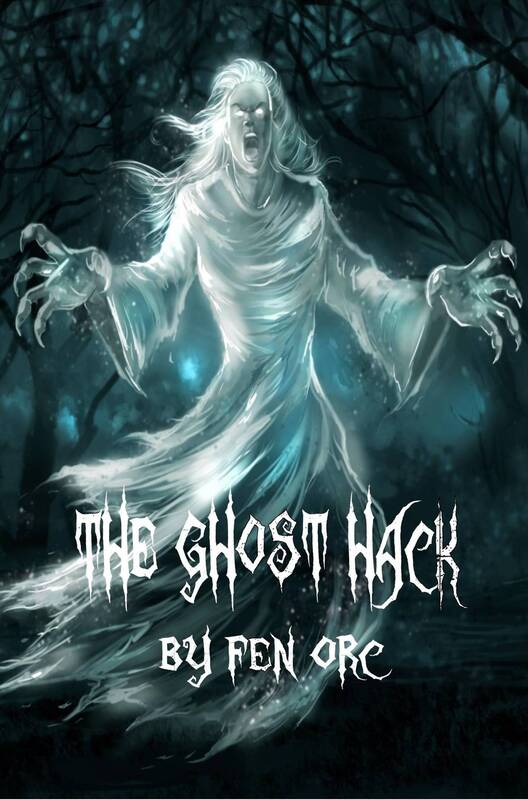
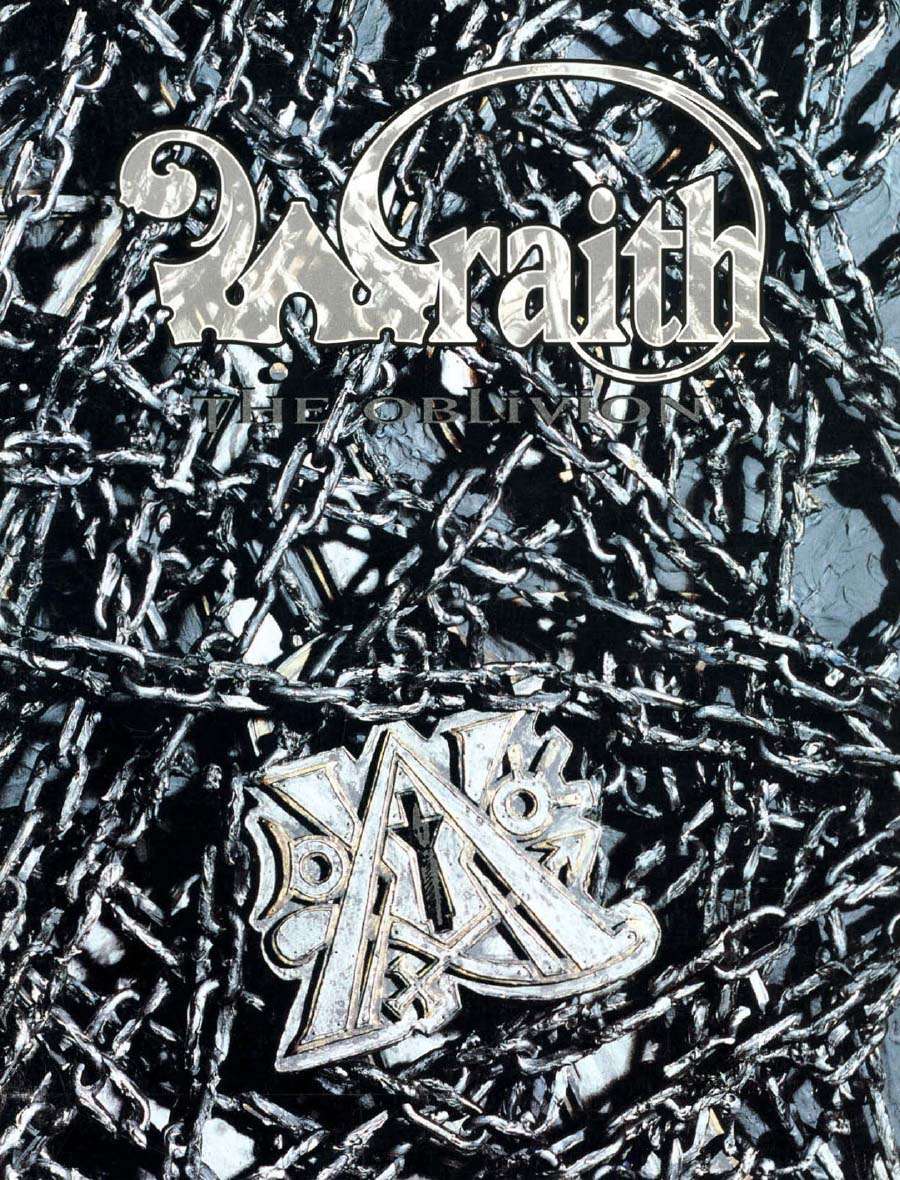
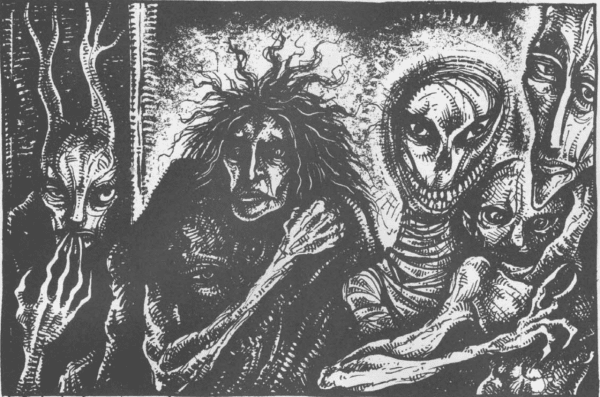
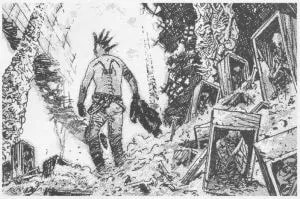
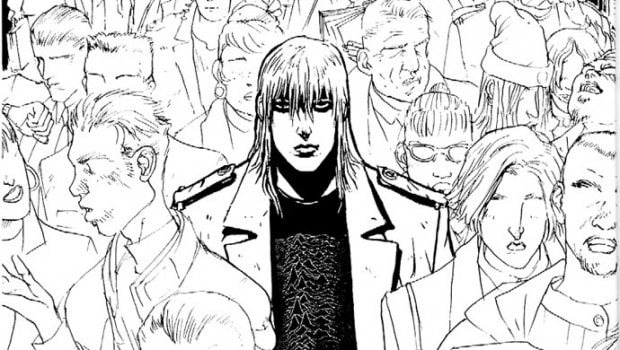
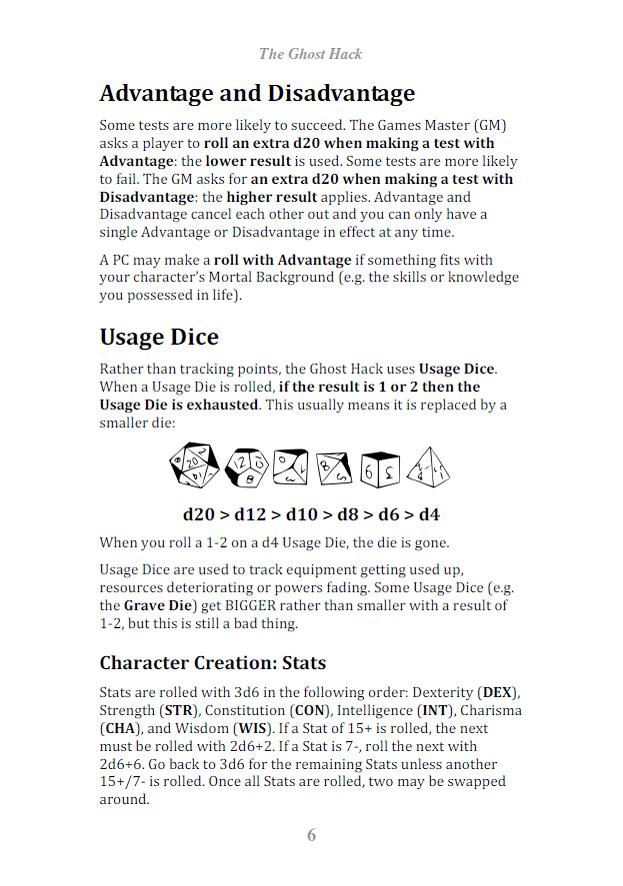
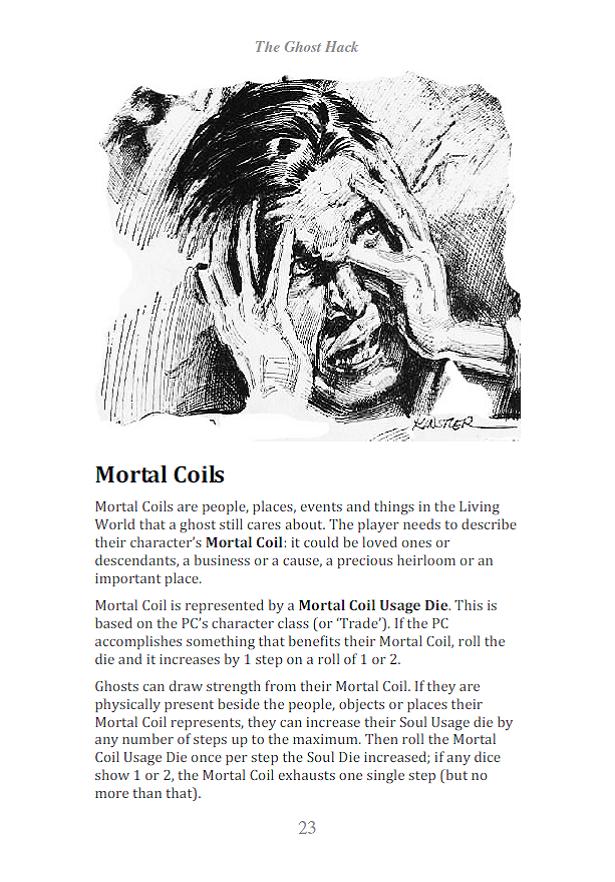
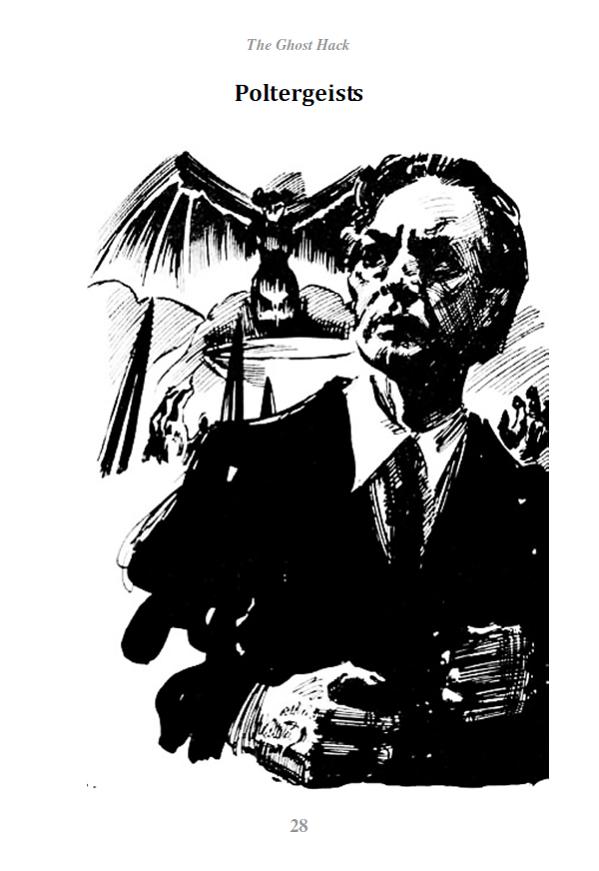

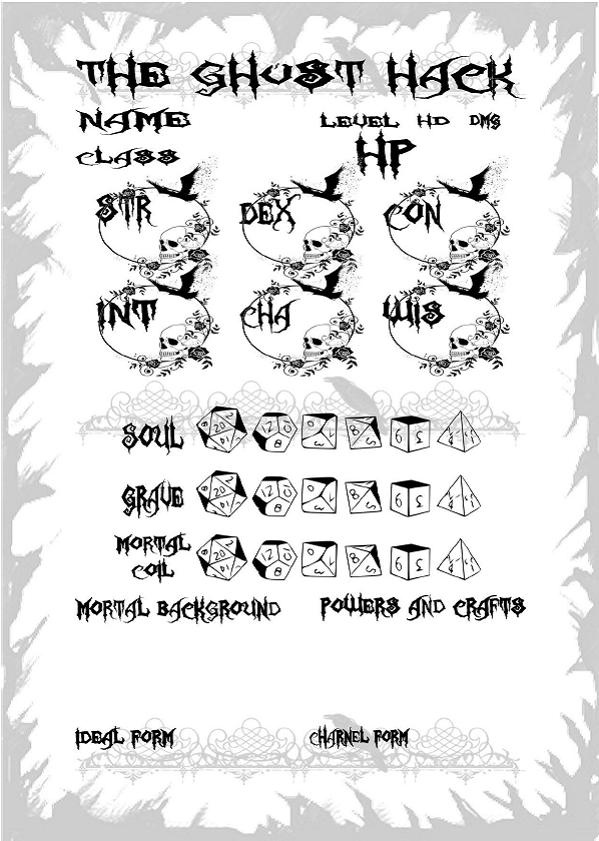
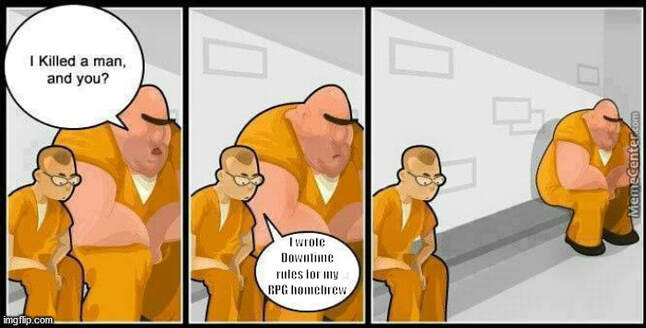


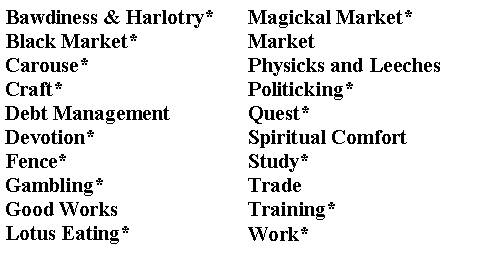
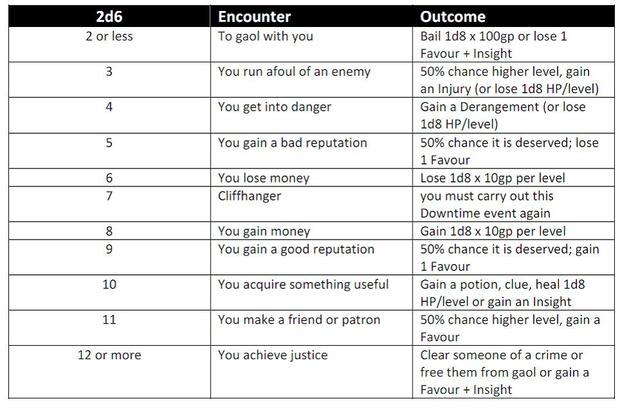
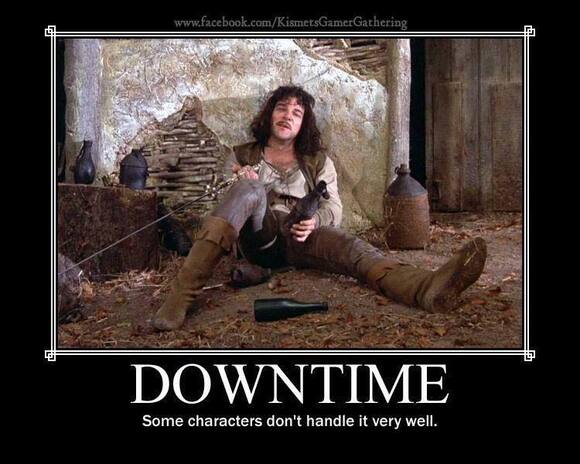
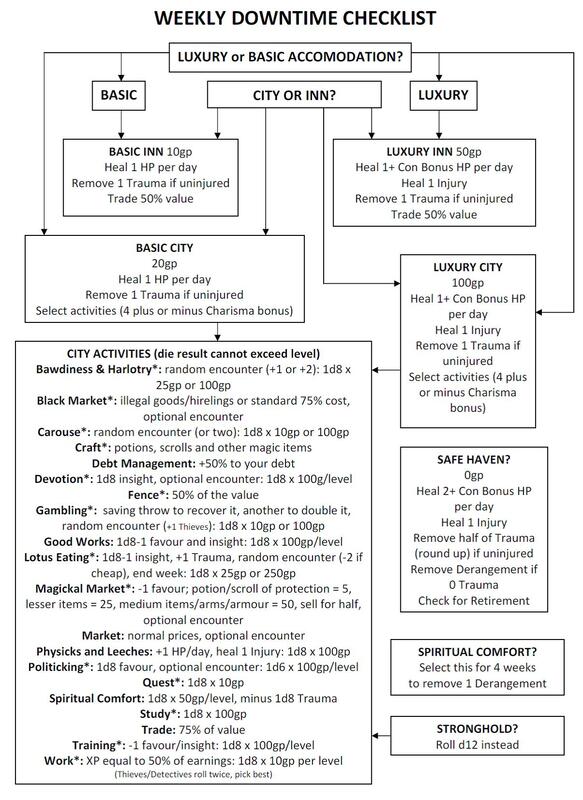
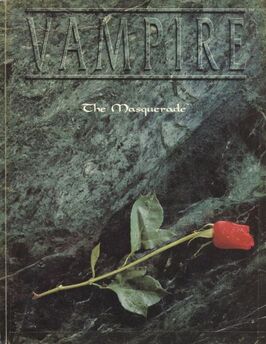
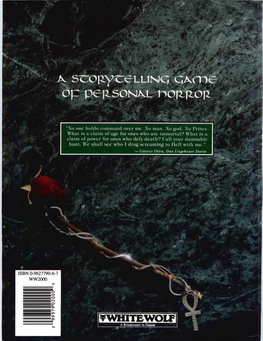
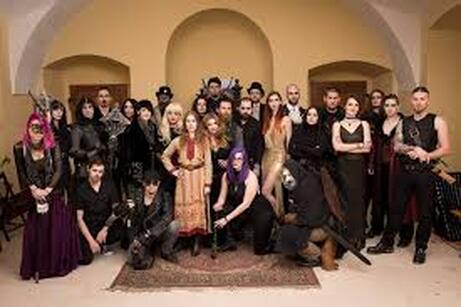
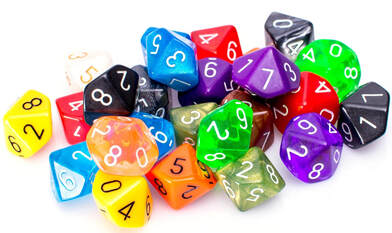
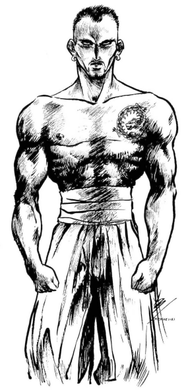
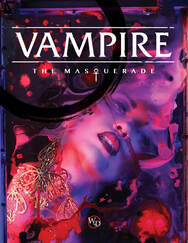
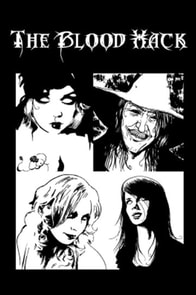
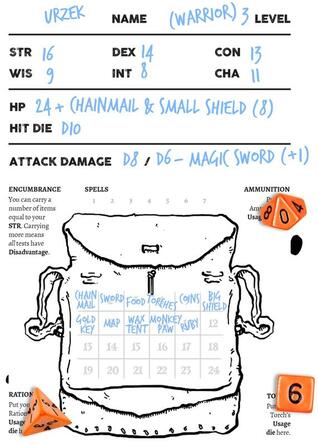
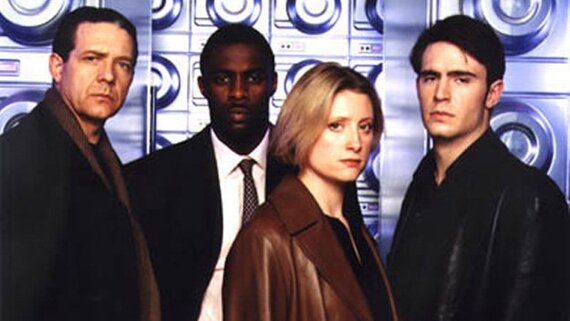
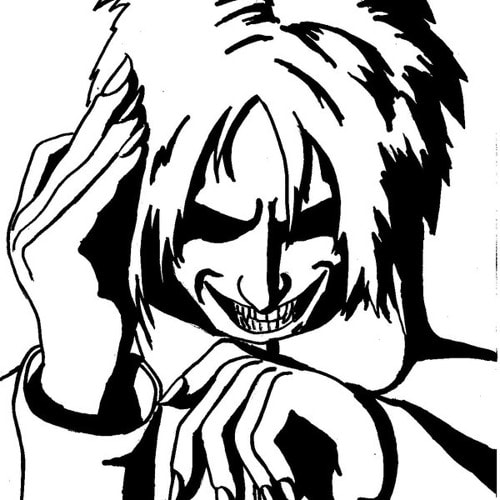
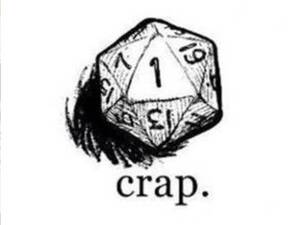
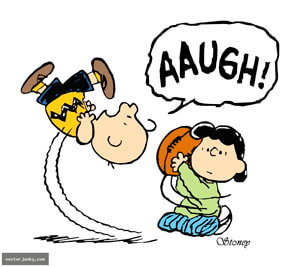
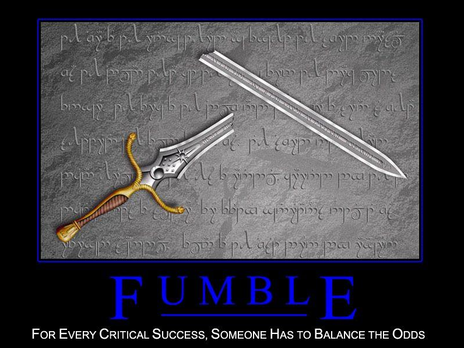

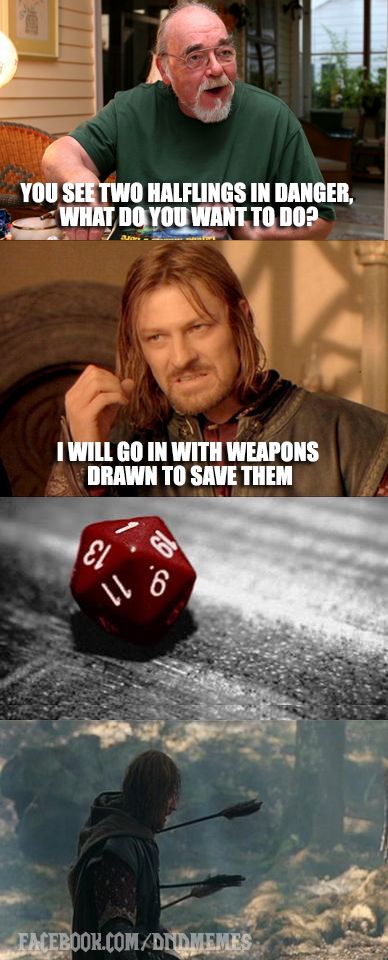
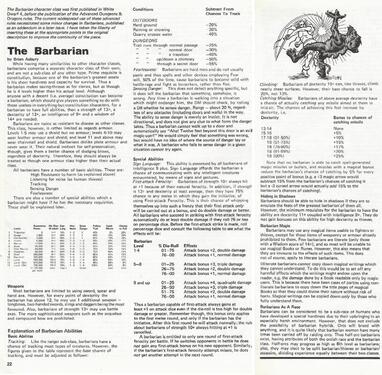
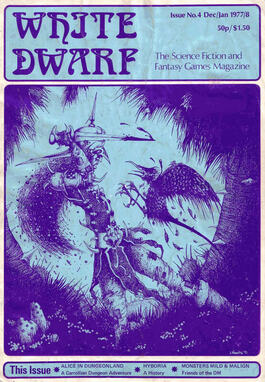
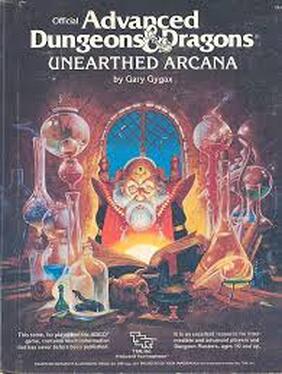
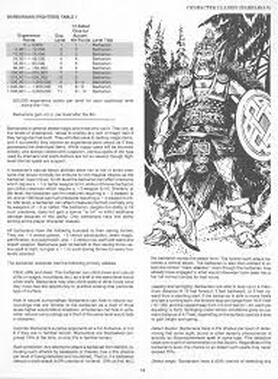
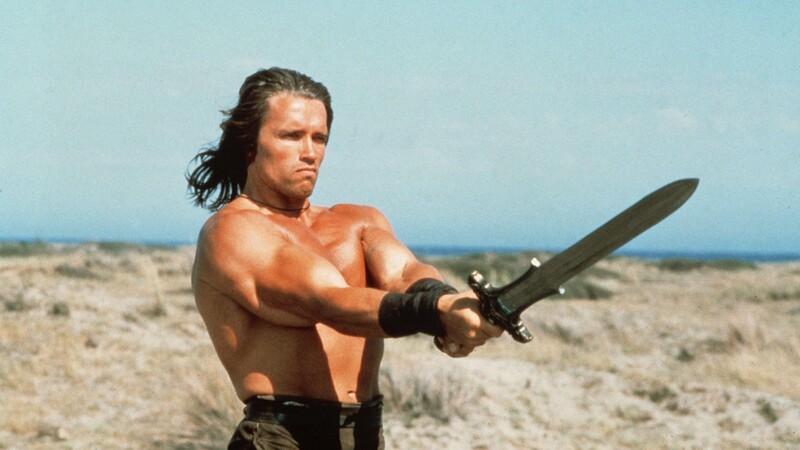
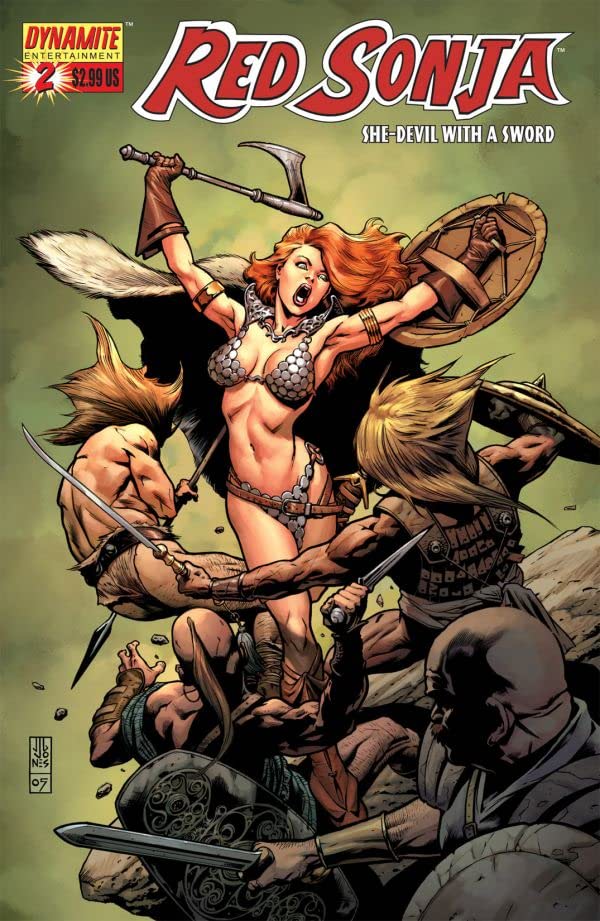
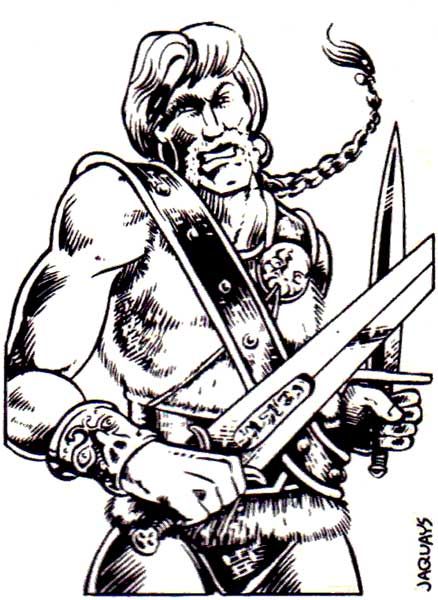
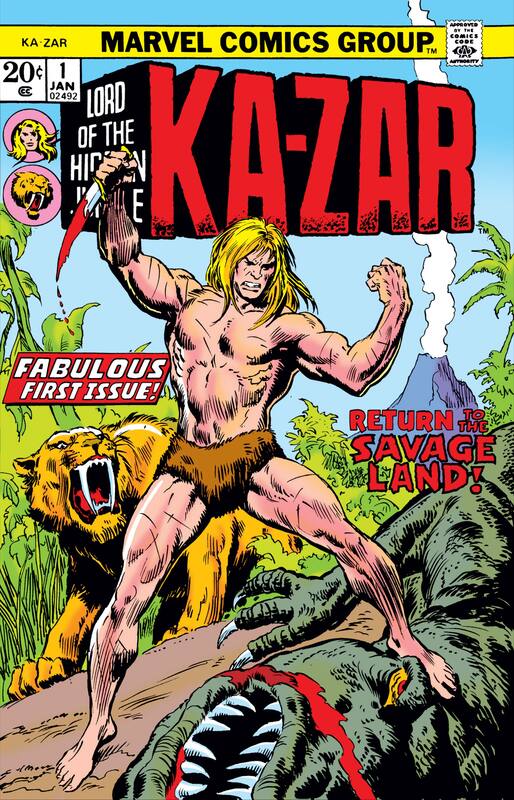

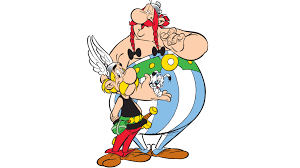
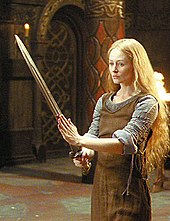
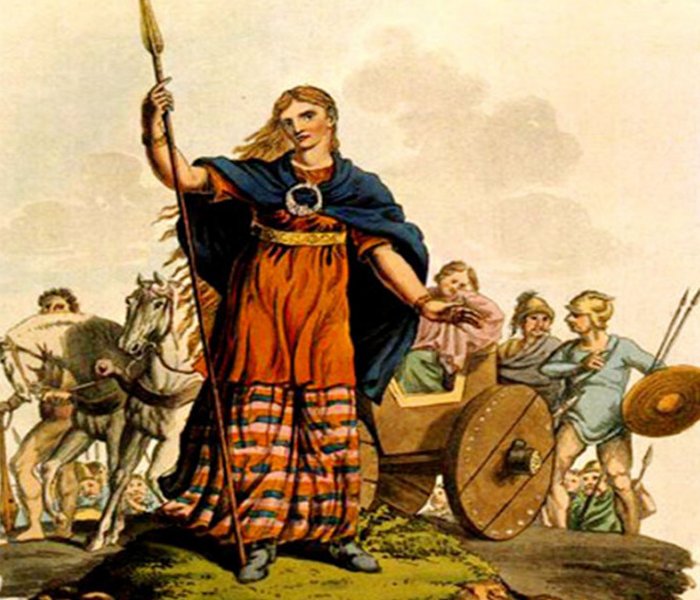
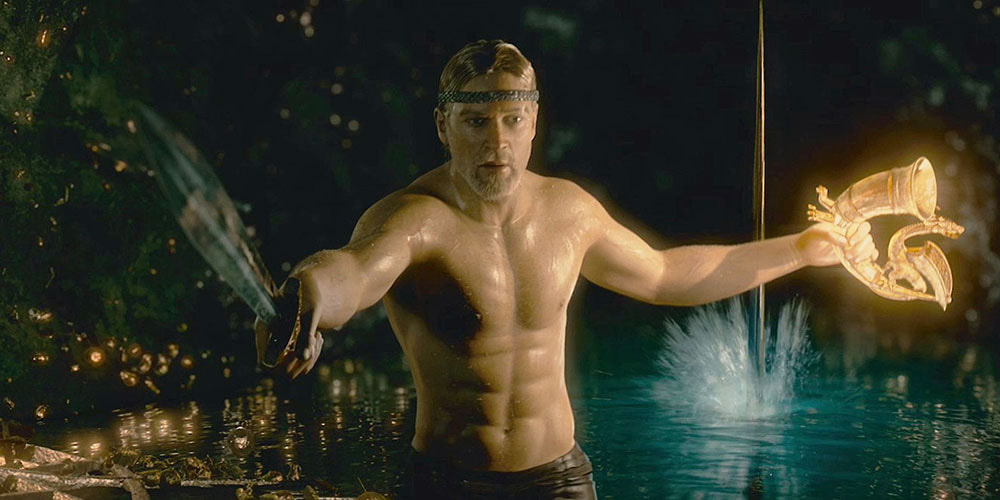
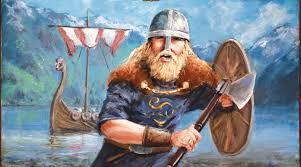
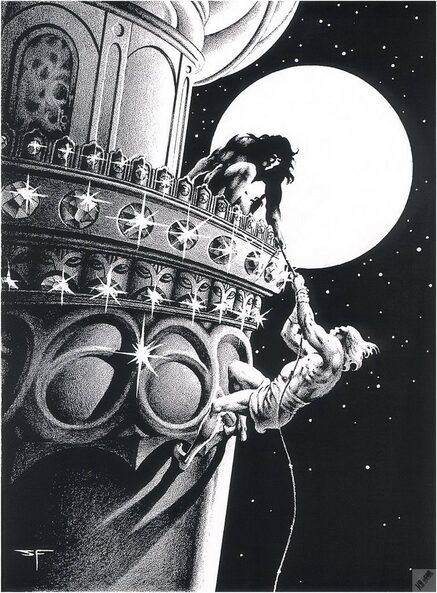
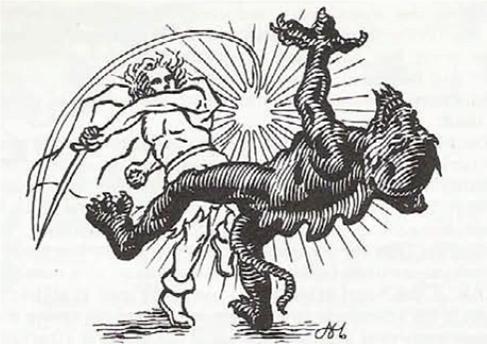
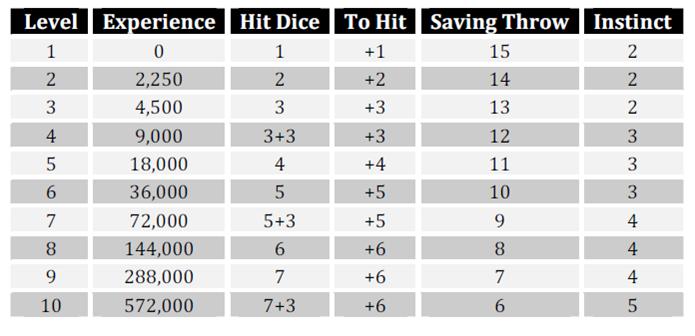
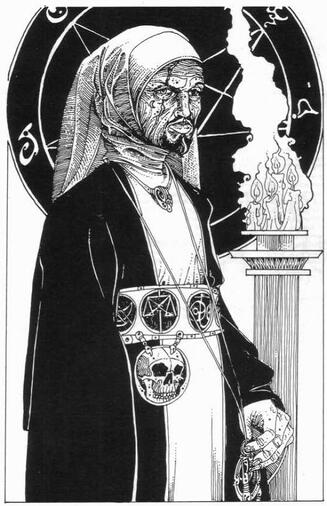
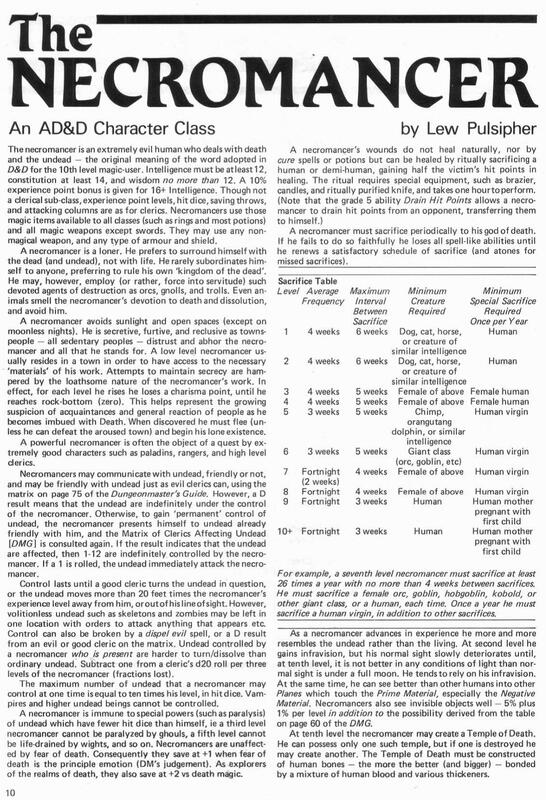
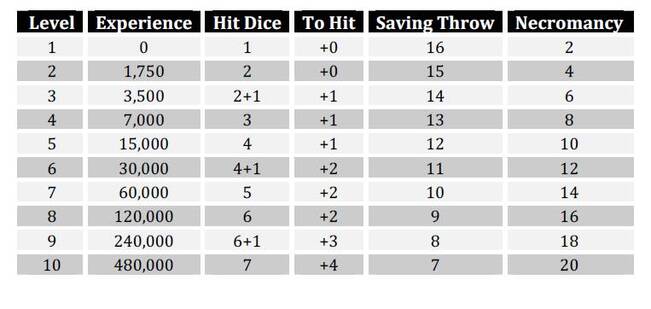
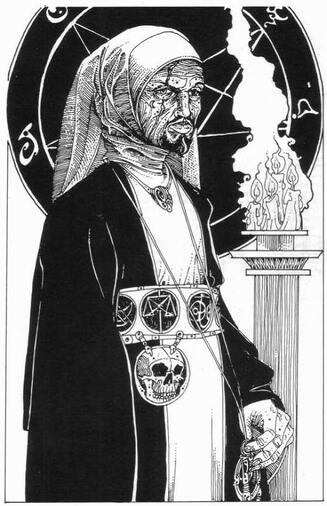
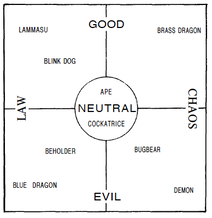
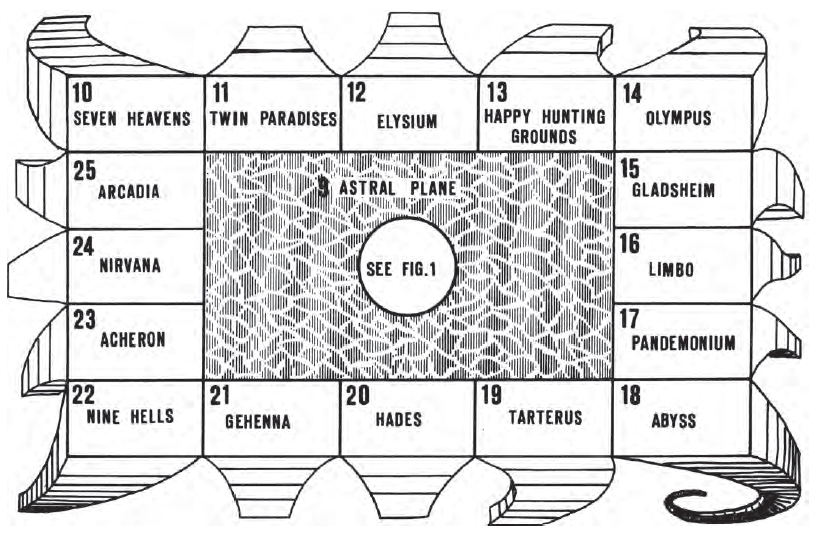
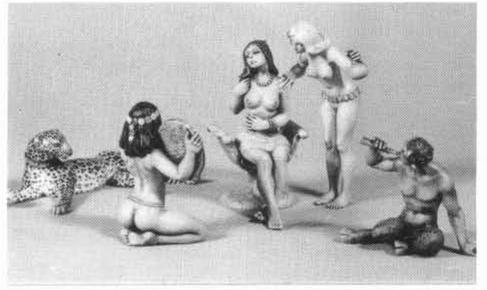
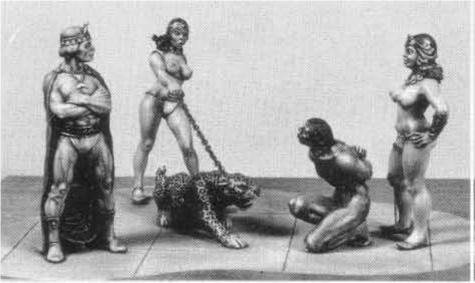
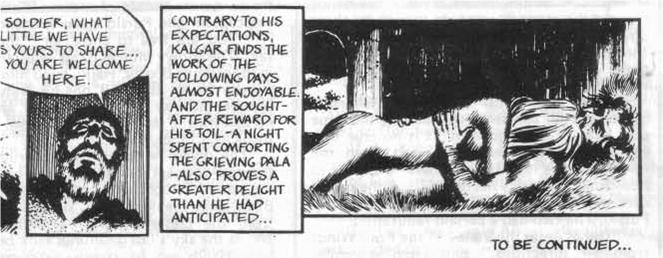
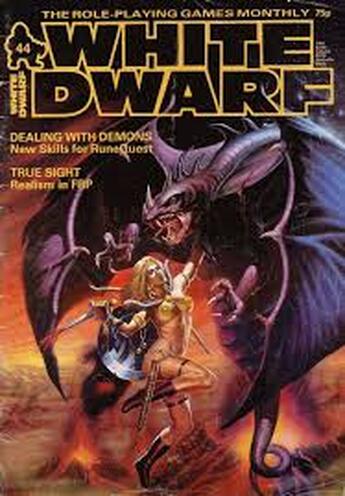
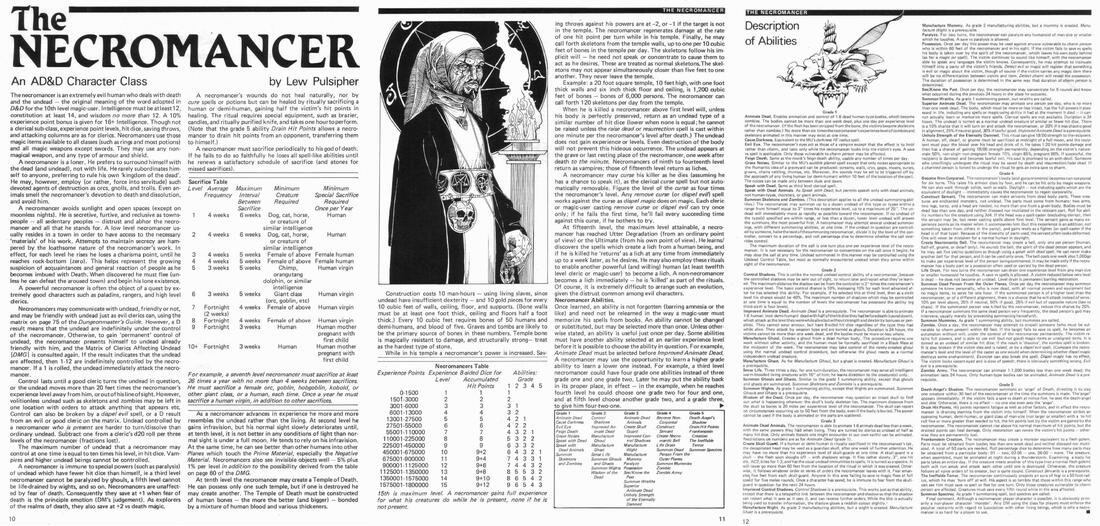
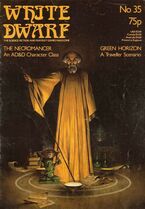

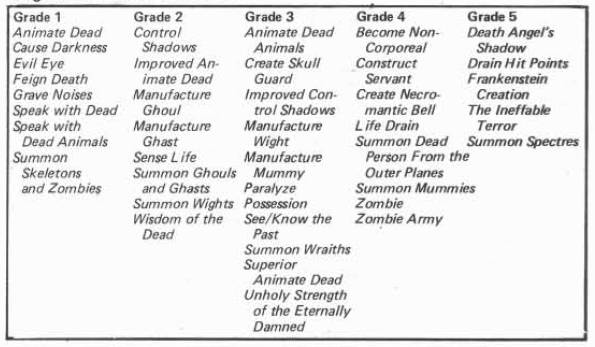
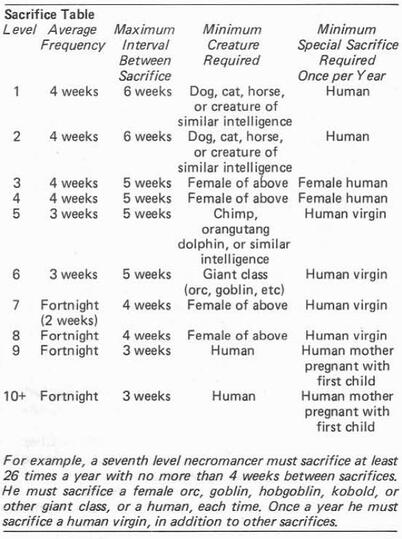
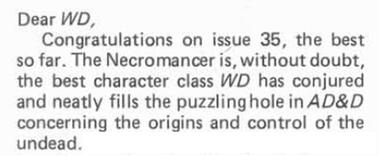
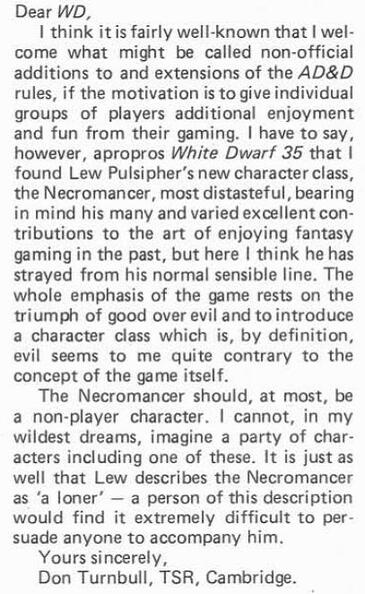
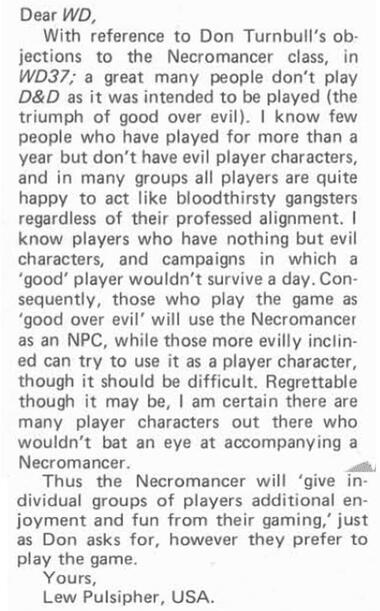
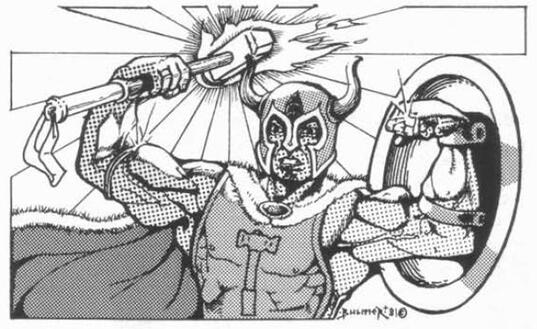
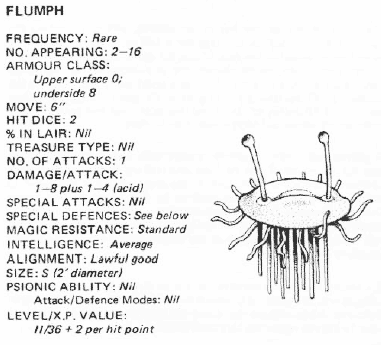
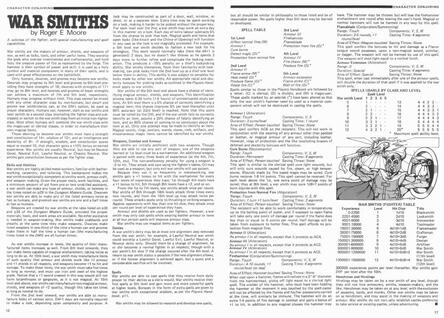
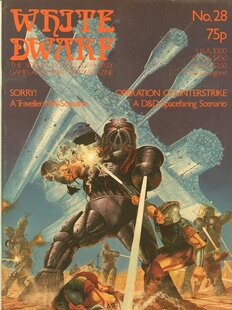
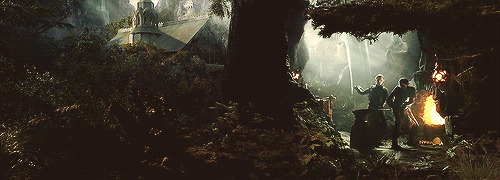
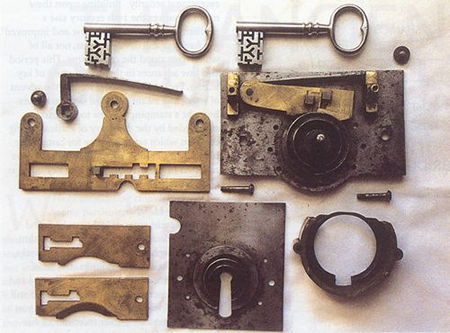
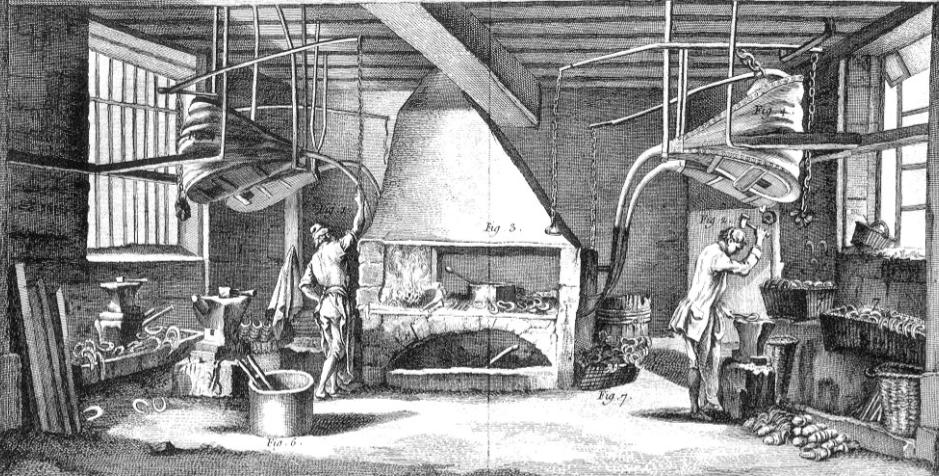

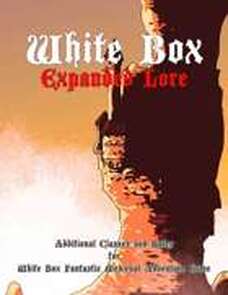
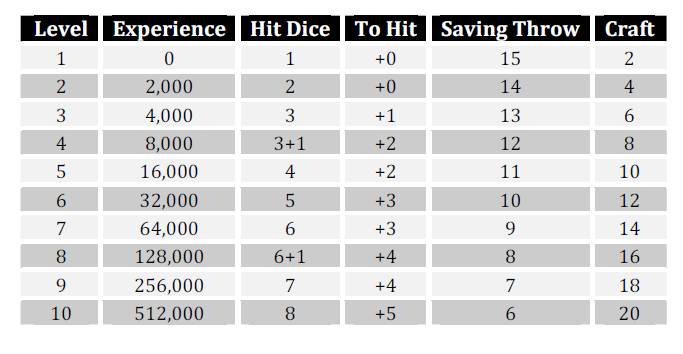

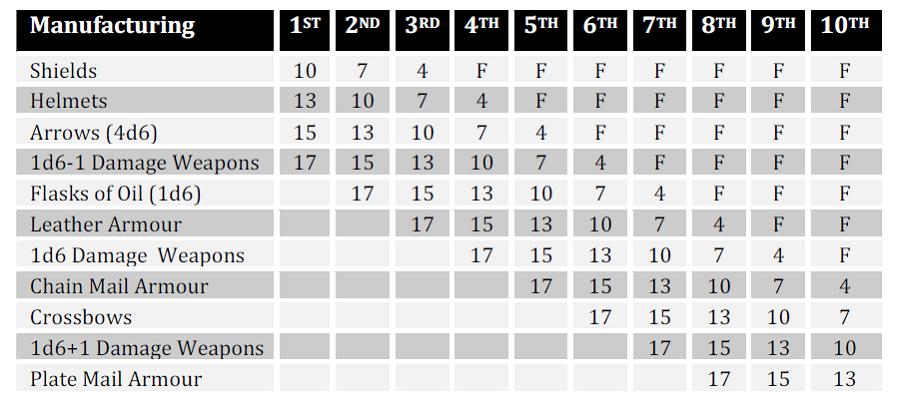
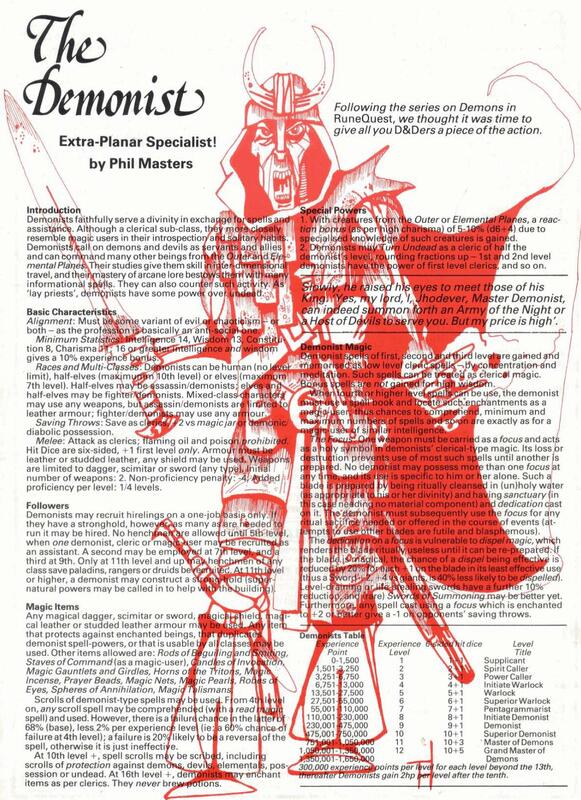
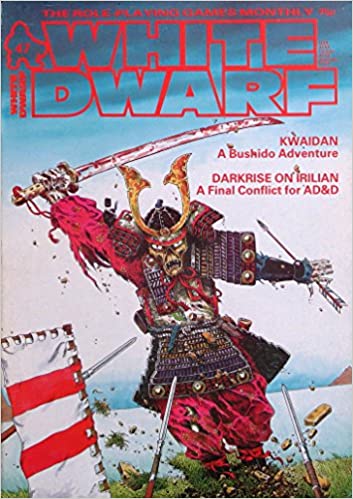

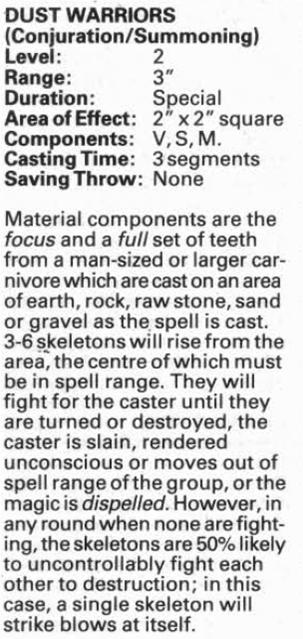

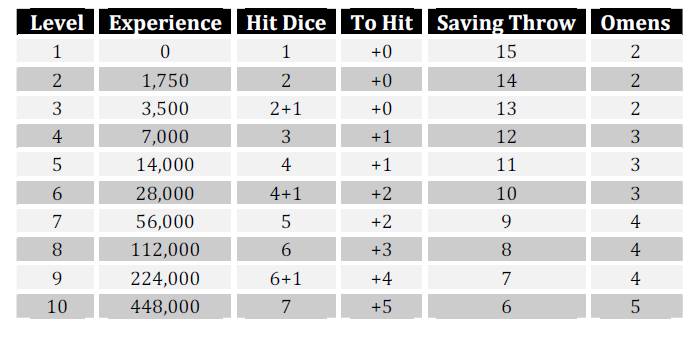
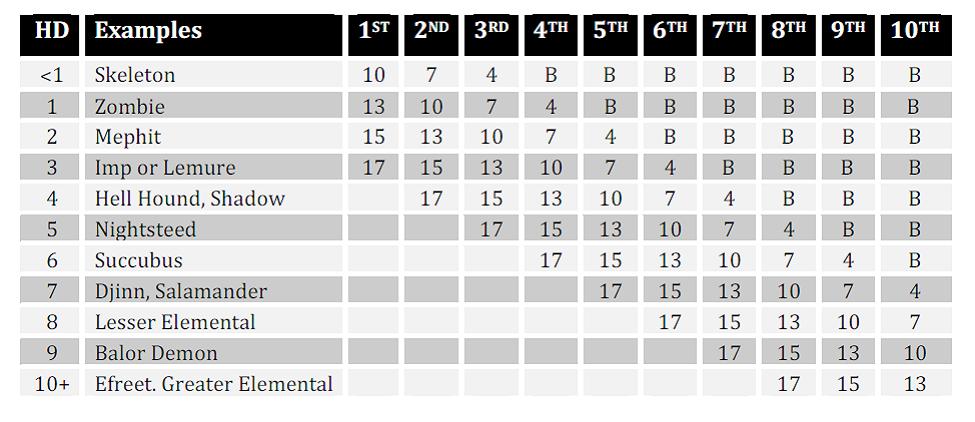
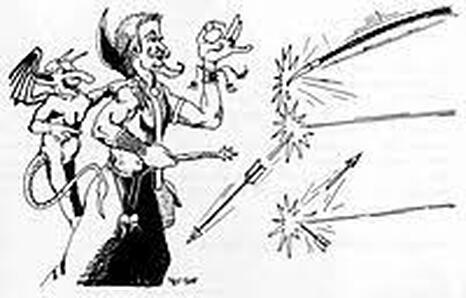
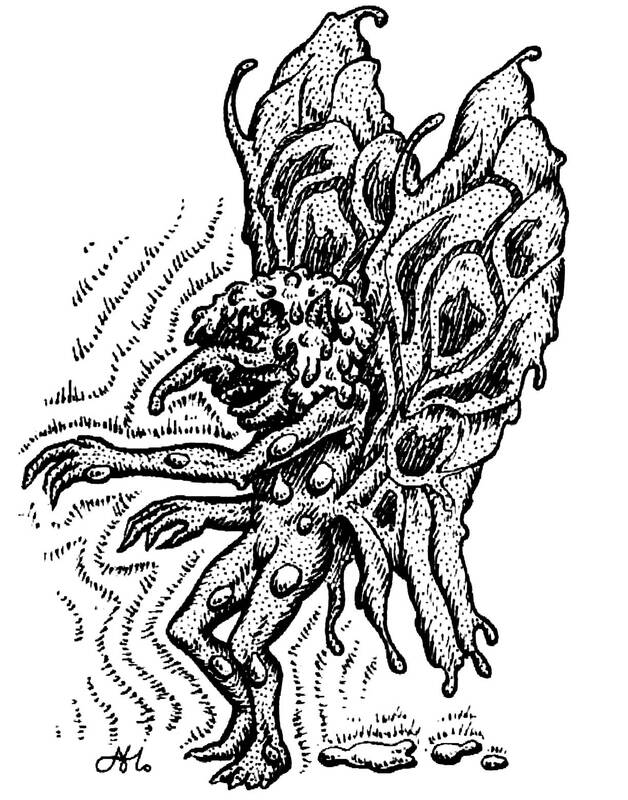
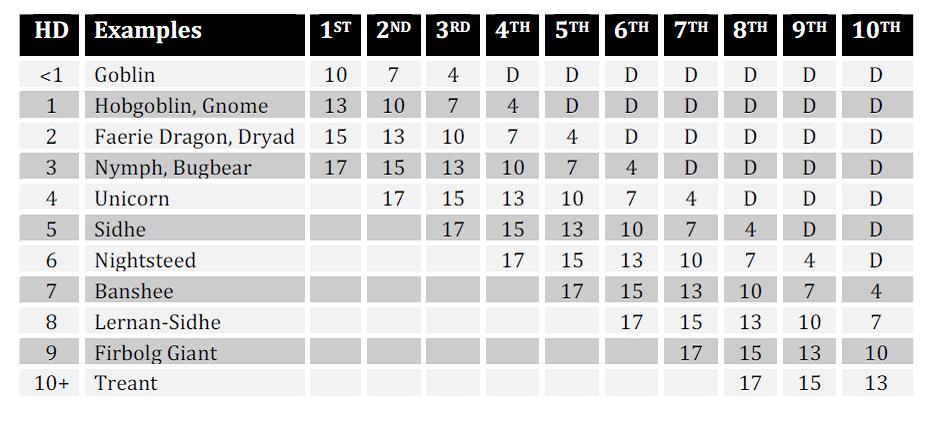
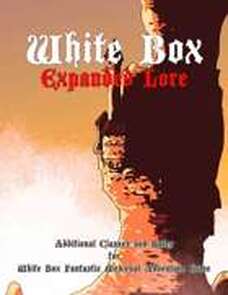

 RSS Feed
RSS Feed
